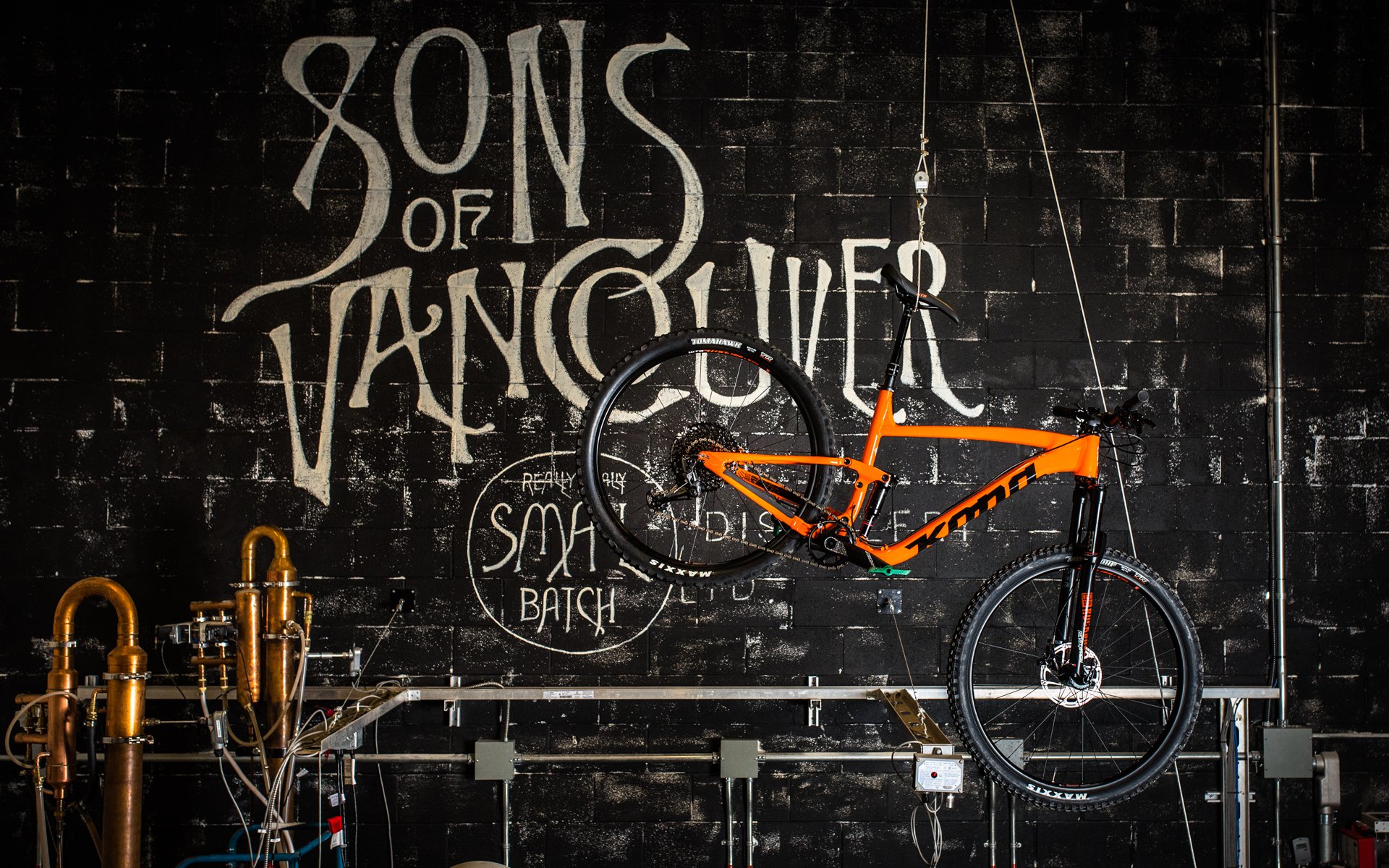
First Impressions
2018 Kona Satori DL
Kona Bicycles
I have alternatively heard Kona called 'The World's Largest Small Bike Company' and 'The World's Smallest Large Bike Company'. Either way, the distinction is easily explained. They're big enough to deliver good value and support, but they still deliver interesting, original, and often prophetic bicycles.
A great example is the Process 111 29'er, introduced in 2014, with its short stays, how-low-can-you-go bottom bracket height, relatively long reach, and 1x specific design. Other favorites of mine are the various generations of Kona Unit, the 2012 steel Honzo, and the simple old-school steel Honky Tonk road bike.
Today I'm writing about Kona's newest full suspension bike, the Satori. It's distilled from the Hei Hei trail bike lineup, the Process 111, and the ahead-of-its-time 130mm travel 2012 Kona bike of the same name. That sounds spicy like Chili infused Vodka so Dave headed to Sons Of Vancouver Distillery for some suitable ambiance.

Interesting bike meets interesting space.
VS. 2012 Satori
I owned a 2012.5 Satori. It had the awesome and more durable textured-finish grey paint and superior cable routing of the 2013 model along with the threaded bottom bracket of 2012. If I'd purchased a 19" instead of an 18" I'd still have the bike. Much like most the Process 111 bikes I see around, I ran it with a 140mm fork. That's how the 2018 model comes out of the box.
It also has the distinction of being the last mountain bike I owned with a front derailleur, in my this case, actuated by a friction thumb shifter.
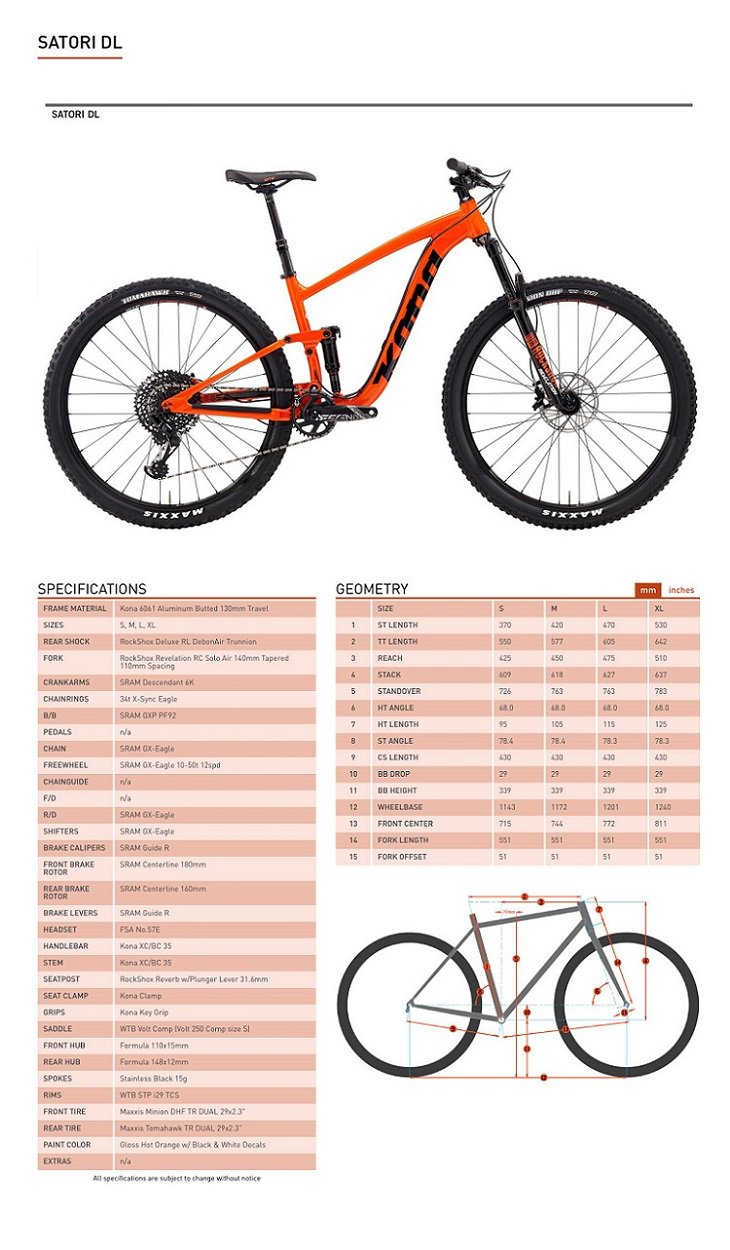
The 2018 Kona Satori
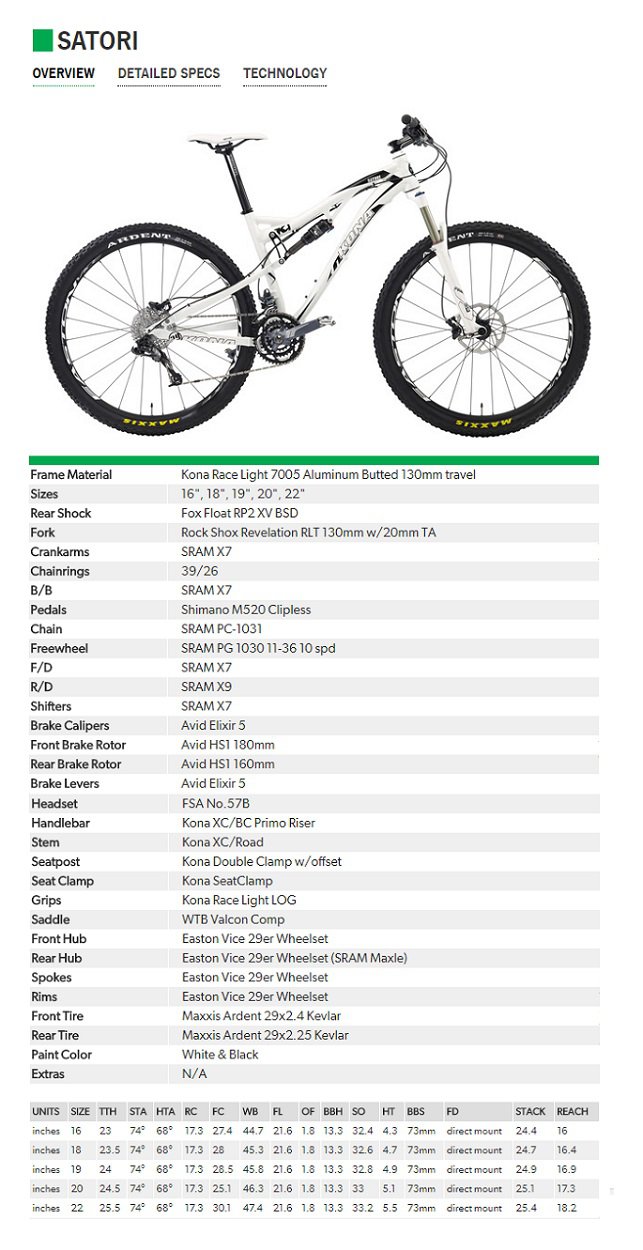
The 2012 Kona Satori
On paper, the only geometry carry over from six years ago is the 68-degree head tube angle but a large 2018 Satori and 19" 2012 actually have similar seated riding positions as well.
The 2018 model has a 25mm longer reach dimension but during seated climbing that distance is easily swallowed up by the on-trend 78.3-degree seat tube angle, compared to the 74-degree angle in 2012. Likewise, the body position over the wheel during seated climbing feels very similar despite the longer stays on the 2012 model.
The out of the saddle fit is also quite similar although I ran a 70mm stem for the 2012 model and I'm happy with the 45mm Kona XC/BC stem that's stock on the new model. As an aside, the forged 35mm bar clamp stem is a really nice piece of house brand kit that can often be found, brand new, for cheap as folks upgrade to Gucci options.
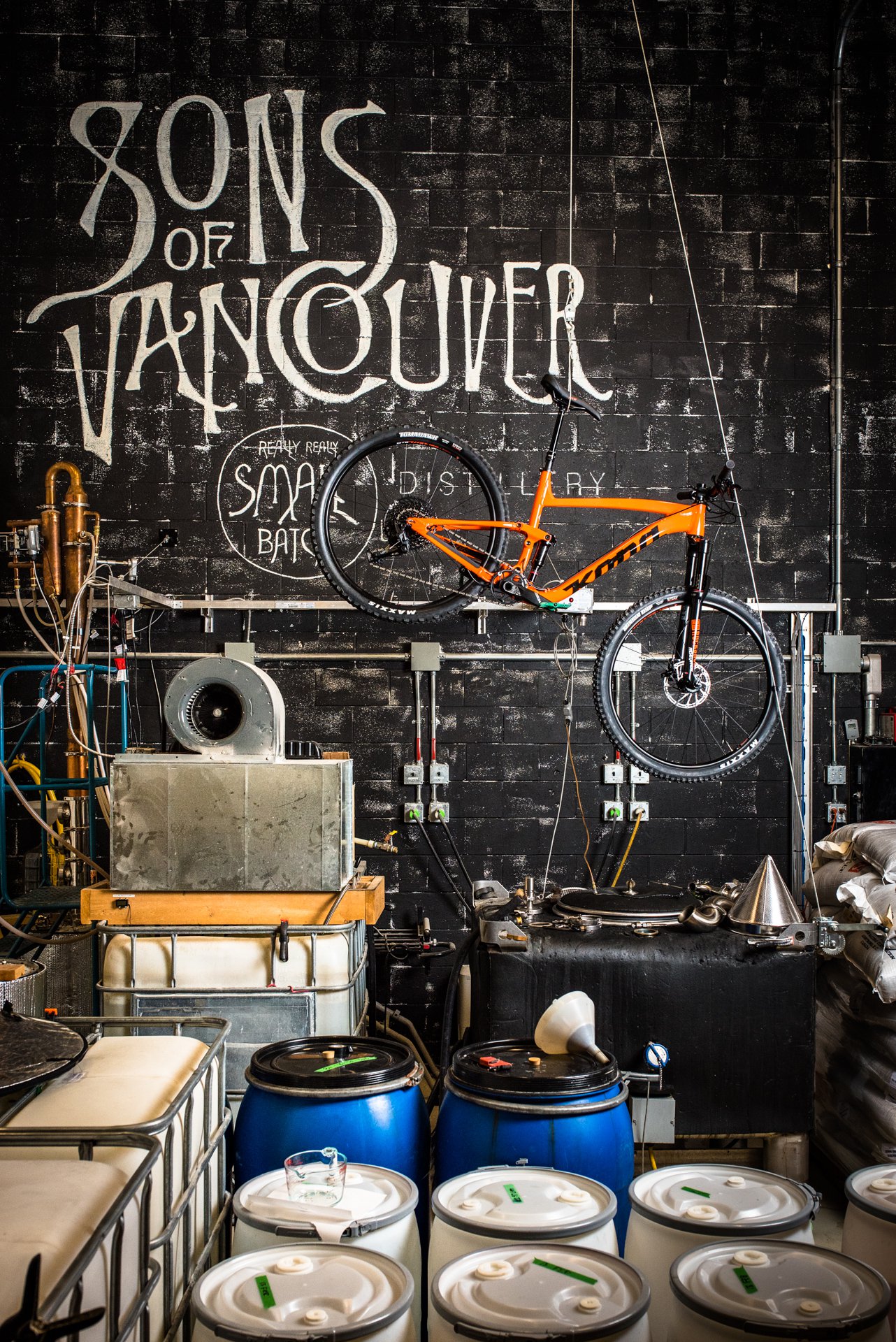
Take a bunch of components...
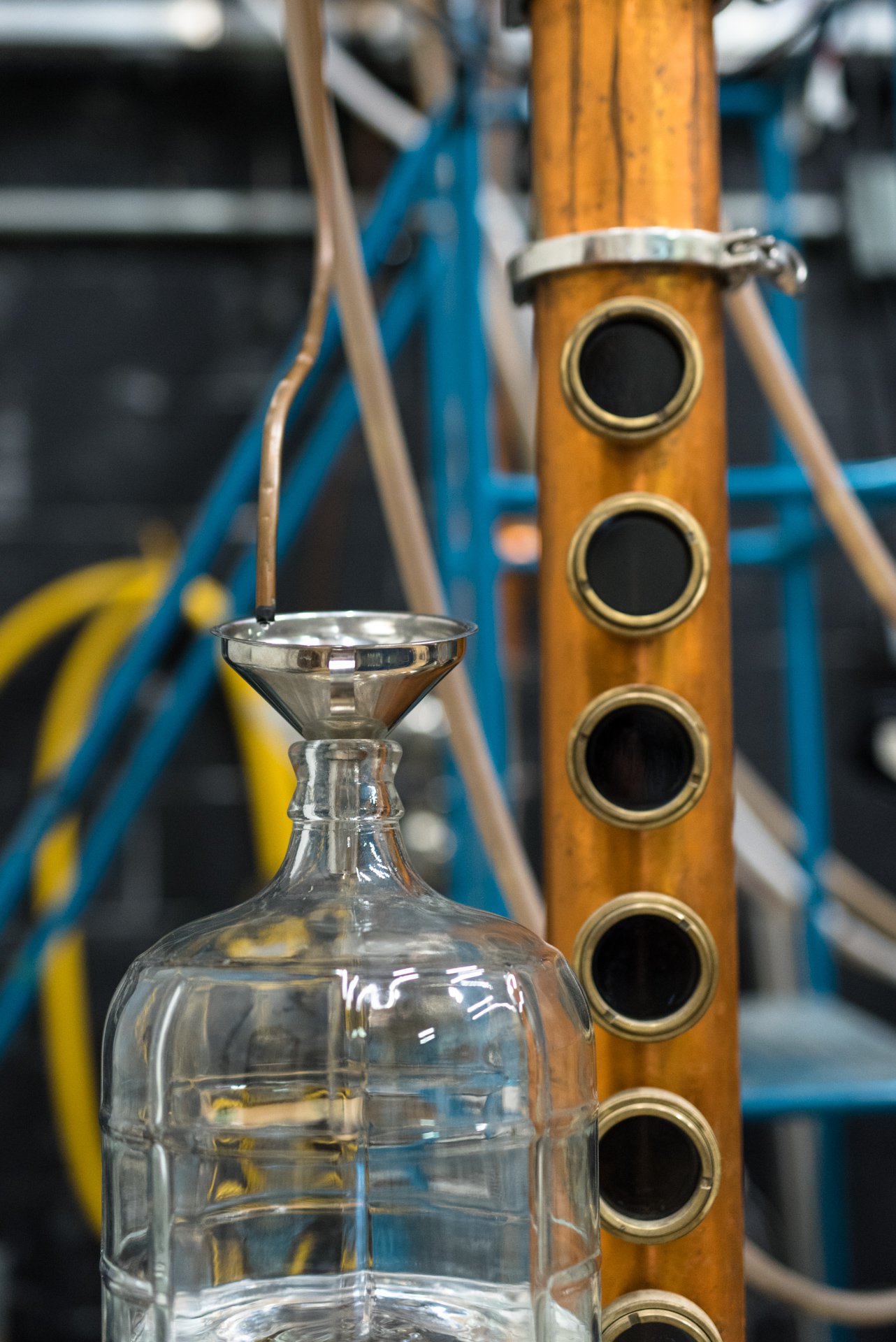
...drip, drip, drip...
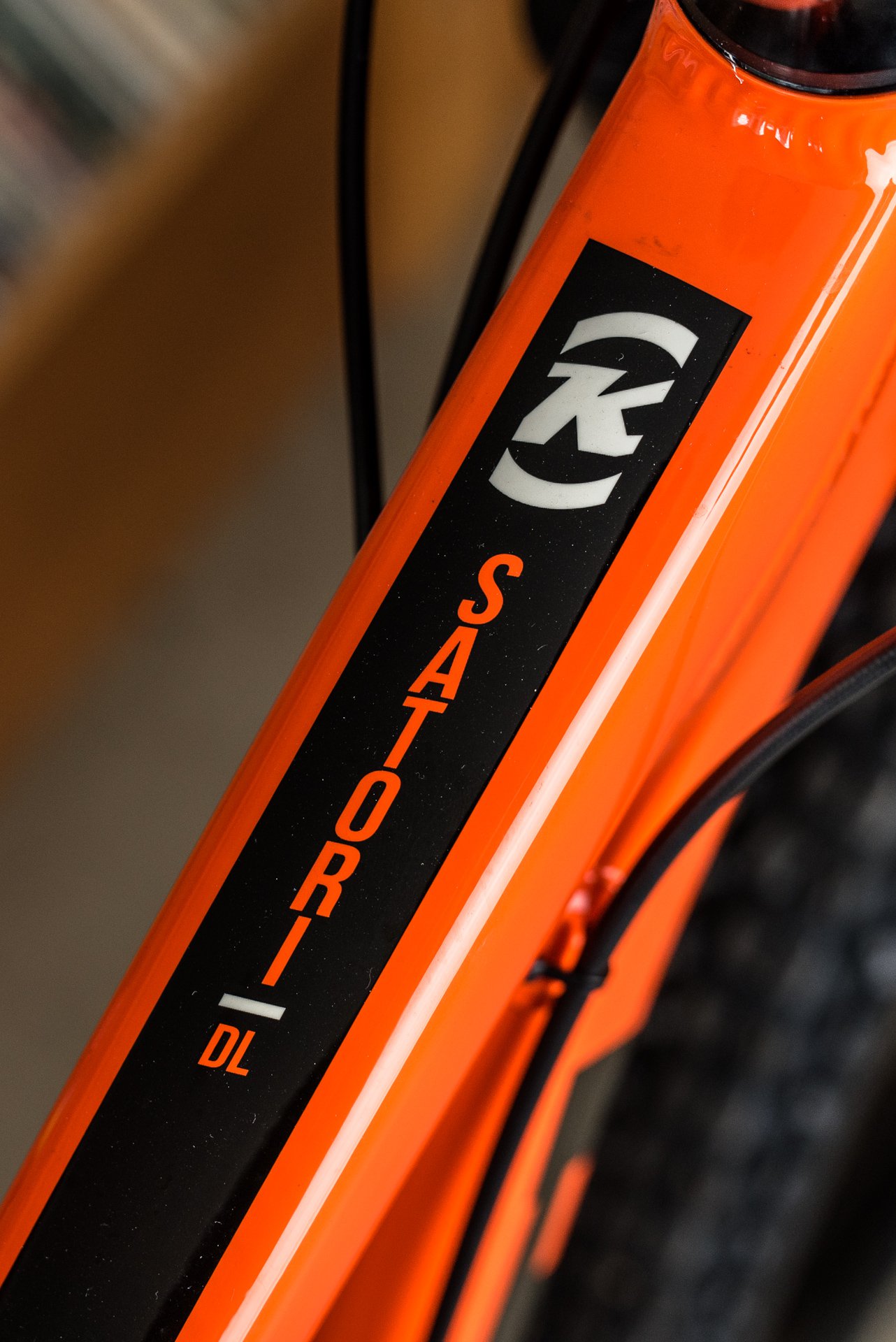
Distill a sweet mountain bike.
VS. Process 111
I know a lot of folks, especially current 111 owners, who were bewildered when Kona released their 2018 Process bikes and the 1x-specific shorter-travel rocket that changed so many opinions about 29'ers was absent.
I only have two short rides on the new Satori and it's obvious that Kona moved to capture the joy, and fit, of their infamous full-suspension Honzo while at the same time resolving two complaints. The first being the lack of a water bottle mount inside the main triangle and the second being an uncommon (7.25" x 1.75") shock size.
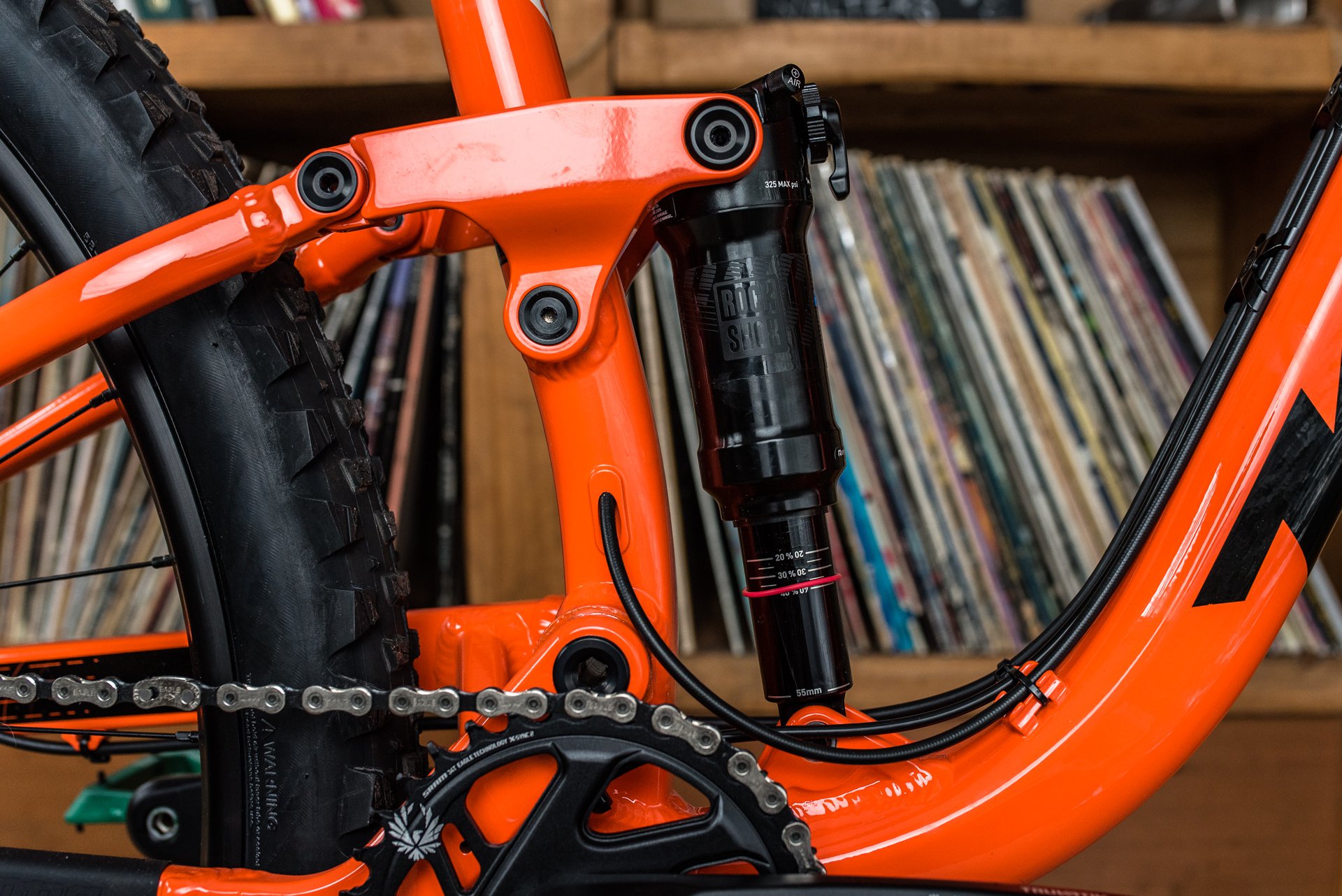
A Metric RockShox Deluxe means future upgrade options abound.

The trunnion mount means more oil in the shock and bearings instead of a DU bushing.
I'm very familiar with the size large Process 111 and standing on the bike this large Satori felt right at home. Seated climbing is a slightly different matter, where the Satori's much steeper seat tube angle makes for a shorter cockpit. The fit is perfect for me, at 5'9", but anyone who was on the cusp of an XL Process 111 is going to definitely want to go that way with the replacement.
Kona has a great long-term reputation for supporting taller riders with bikes that fit and I think they'd be well rewarded to support their customers with an XXL version of this bike.

2018 Kona Satori
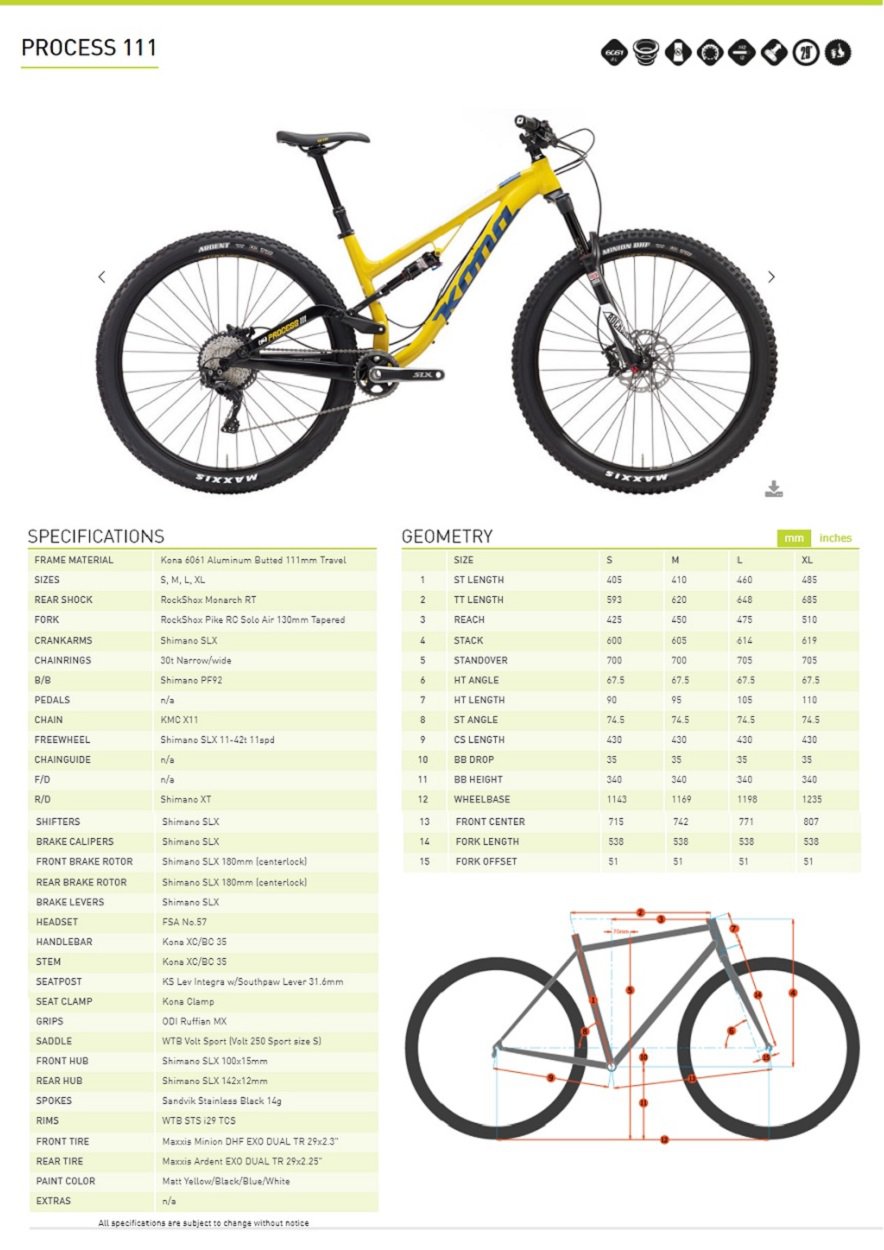
2017 Kona Process 111
Whether it's the vertical shock orientation, the lack of a seat stay pivot, or possibly increased anti-squat the Satori gives up a modicum of initial rear suspension plushness compared to the 111. I think that makes it, even more, the every-person 29'er. I can envision it with Ikons racing participant class in XC races and also being ridden downhill in anger with DH rubber at local Enduro race events.
Spec
This Satori DL is an all SRAM affair except for the well-appointed wheels, which are a Formula meets WTB affair. I don't really understand all the hype around the GX Eagle 12-speed drivetrain. It's not that I don't think it's a great package it's just that I don't see any improvement in performance over GX 11-speed aside from an increased gear range.
On that note, with a 10–50t cassette, I find Kona's decision to spec a 34t chainring bizarre. I get it, these bikes are sold worldwide but I've ridden enough places to think that more Satori customers would prefer a 30t up front so on the balance of chainring swaps why not spec a 30t and let flatlanders who want a 140mm 29'er pay for the swap.
Sure, there's a 50t out back mumble-mumble-mumble get fitter etc. Regular folks that live somewhere with big climbs and descents that require aggressive tires know what I'm talking about.
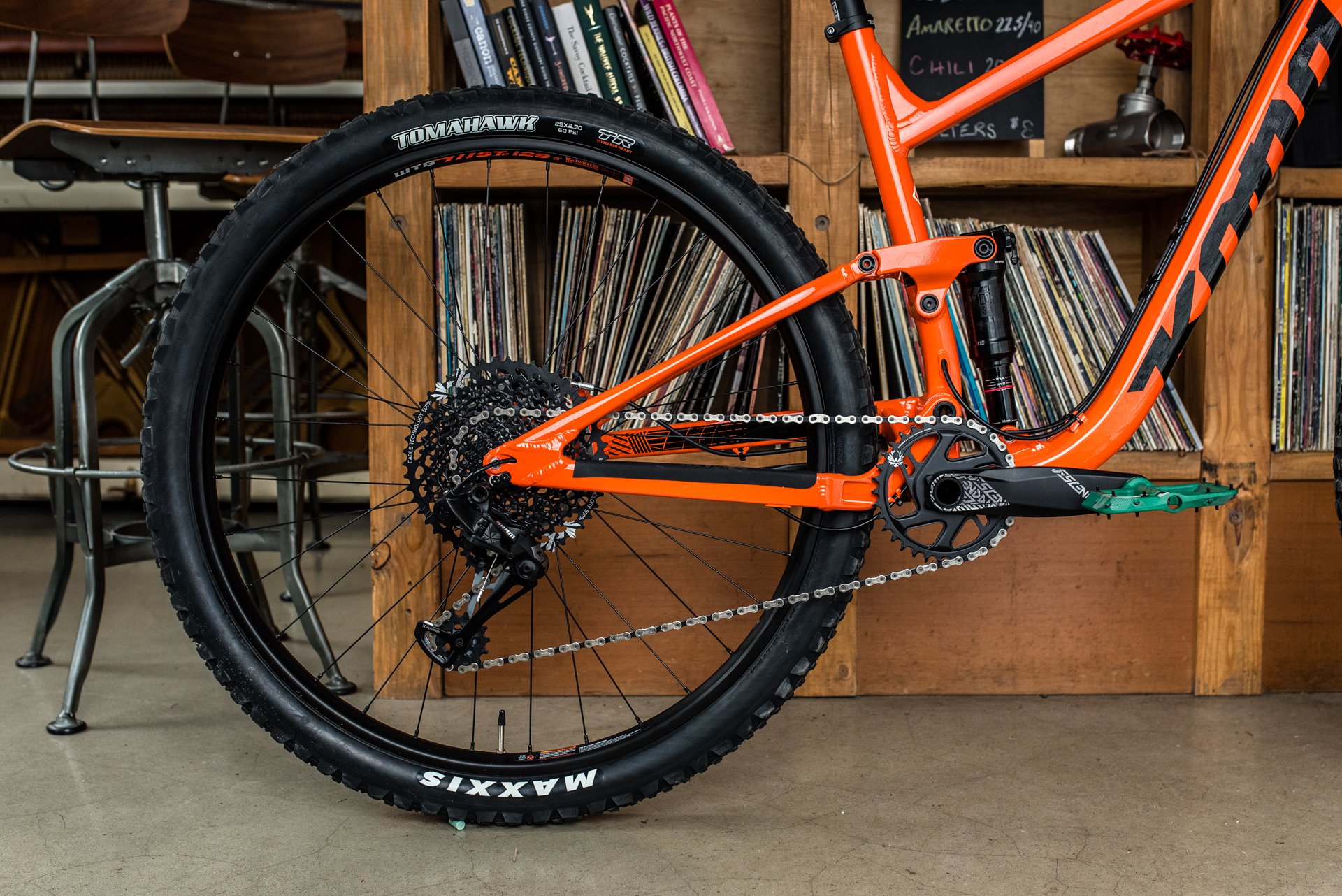
SRAM GX Eagle 12-speed drivetrain. It's very good, like GX 11-speed with extra gears.
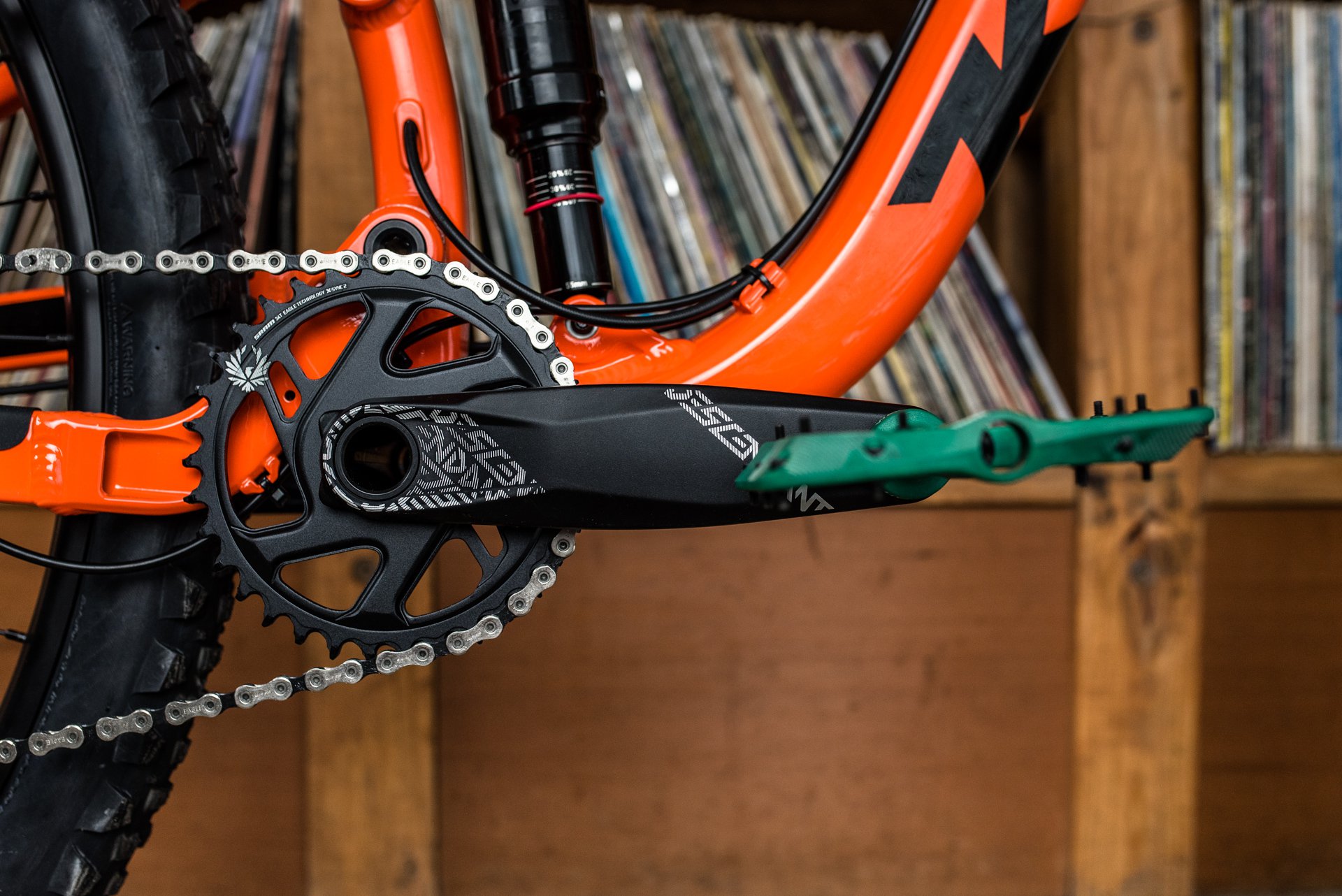
I know Kona sells bikes all over the world but the 34t ring is still a head-scratcher for me.
The all-SRAM program continues and I've never been more joyful to see a set of their Guide brakes. The Code is still the SRAM brake I'd put on everything, but many companies – including Kona – are guilty of entering the Karate Kid in a heavyweight UFC fight by putting Level brakes on bikes where they don't belong. Like the 6" travel Process 153 29'er enduro bike.
If it was my personal rig I'd be running a 200mm rotor up front and swapping the 180mm to the rear. Still, I find the Satori very capable with the stock 180mm front and 160mm rear rotor combo.
I'm also very happy to see all the models of Guide brake are now equipped with their Bleeding Edge quick connect bleed fitting which is best in class.
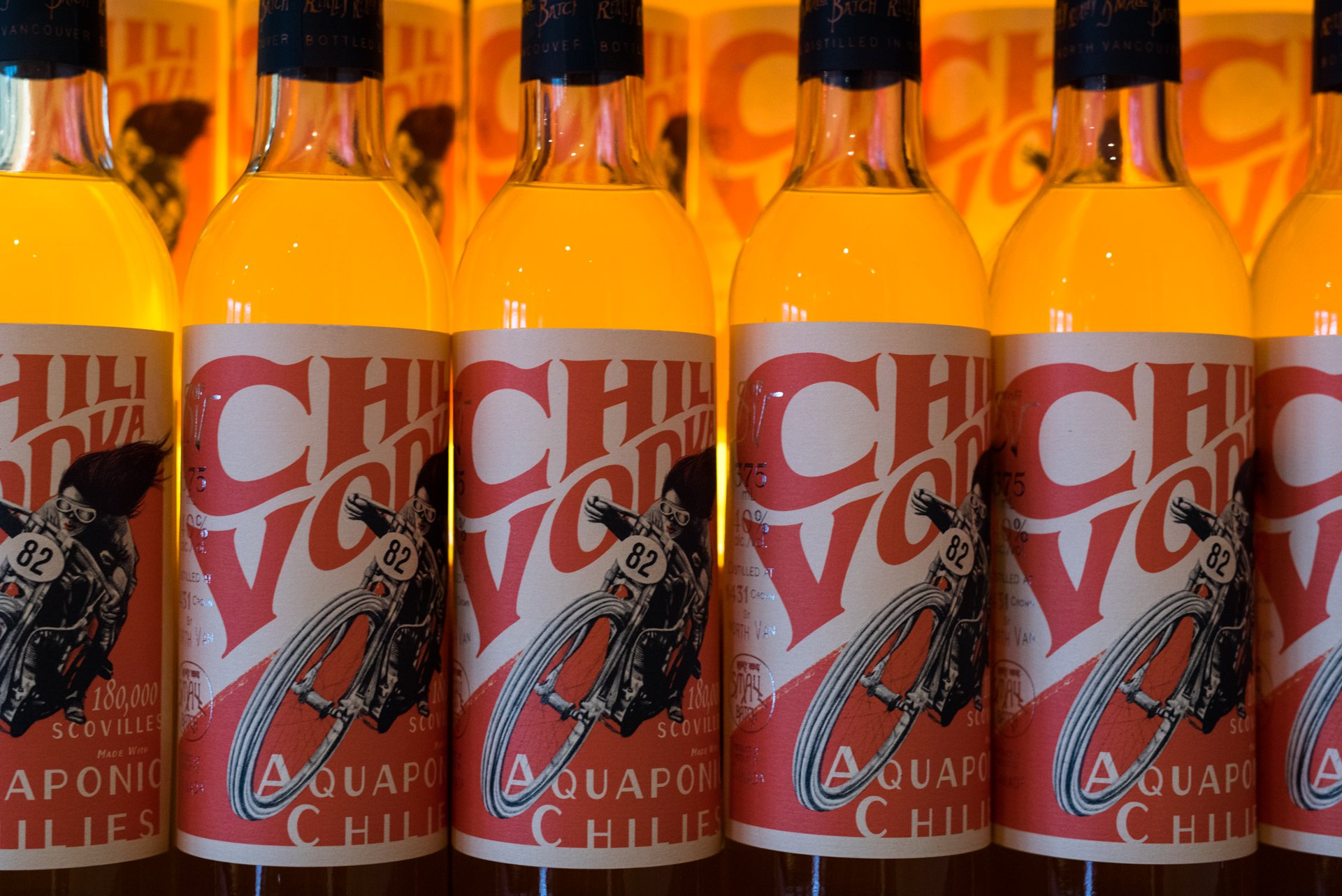
Chili Vodka is apparently for adventurous folks... like mountain bikers.
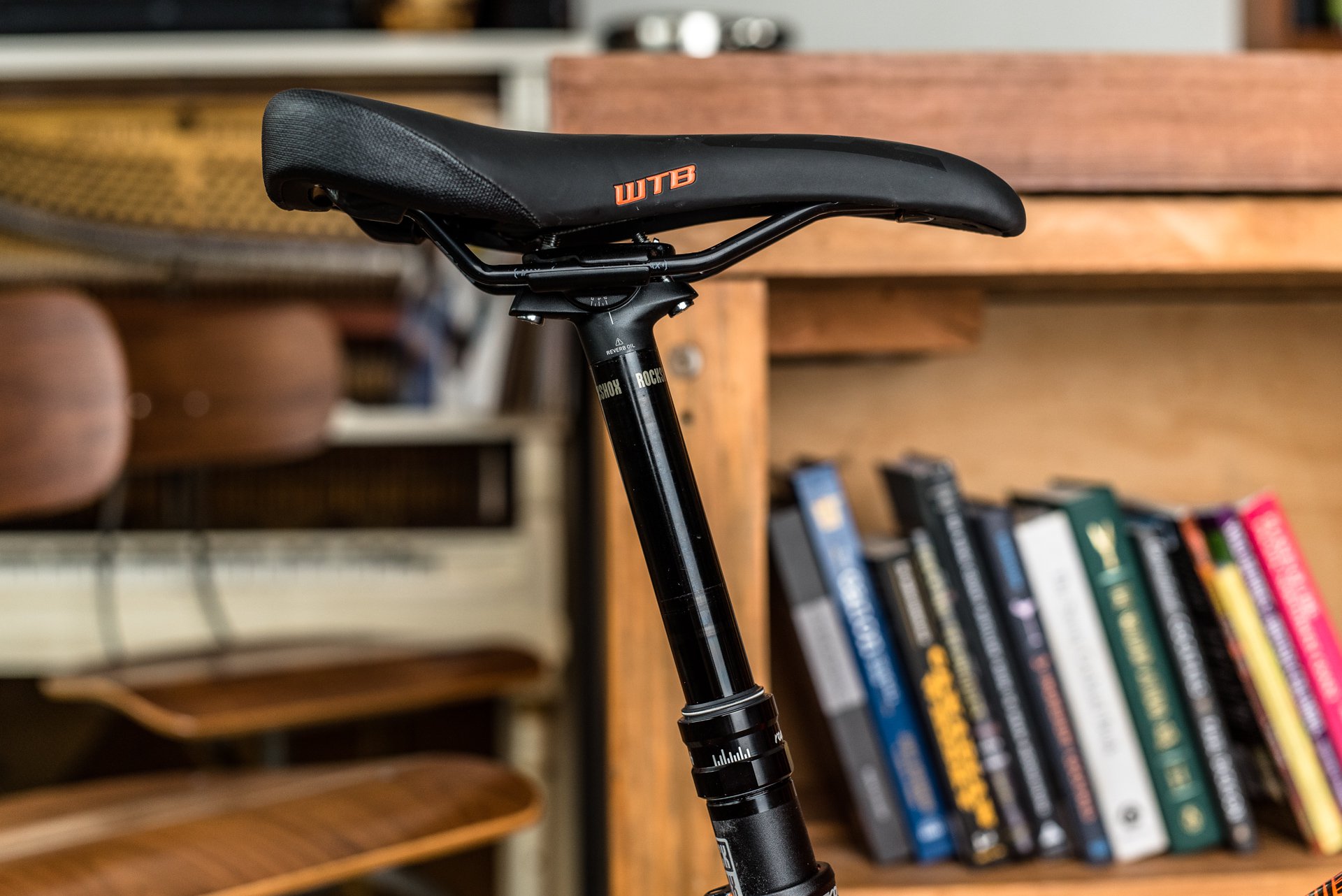
The SRAM-specific build includes a 150mm Reverb.
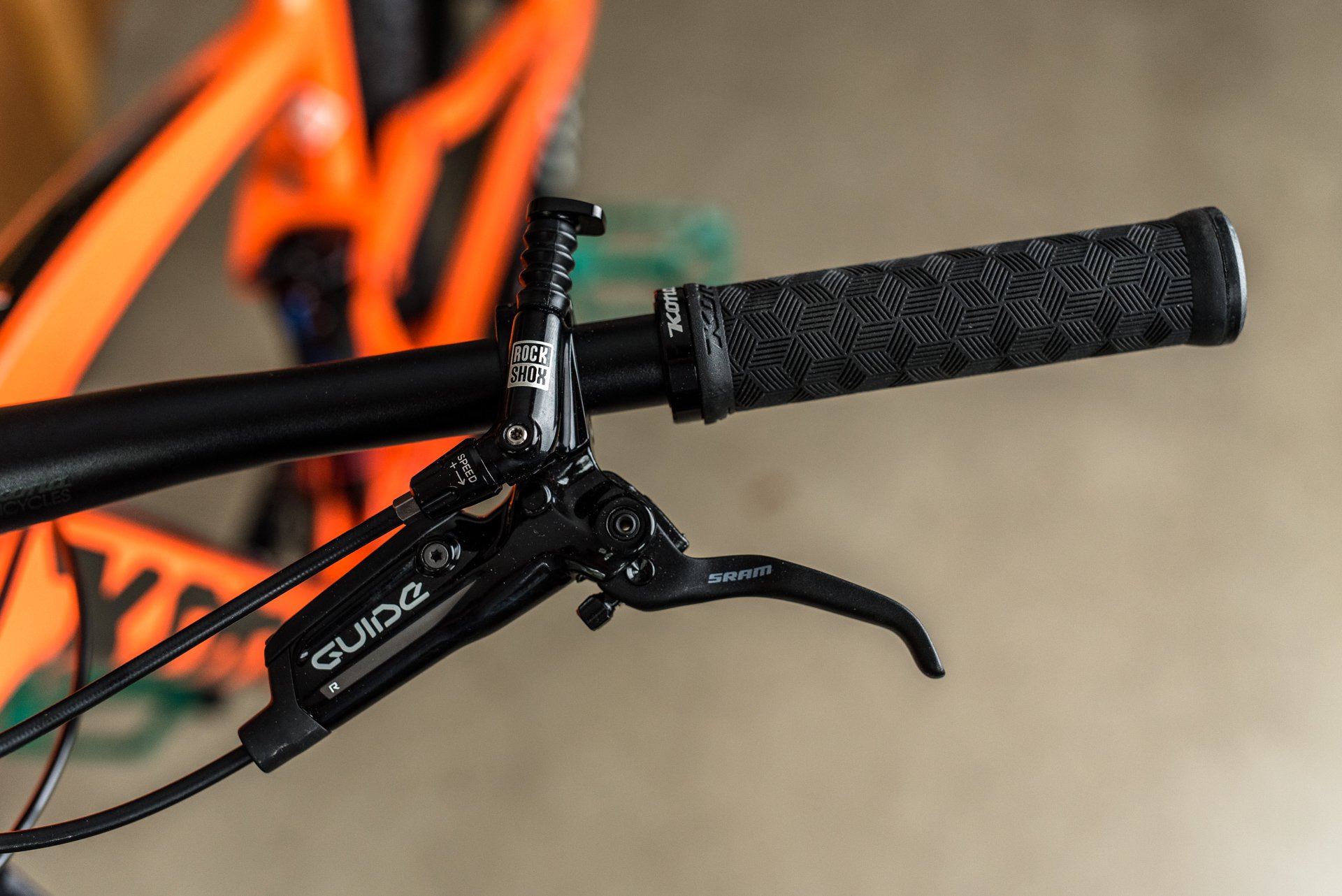
The old style plunger doesn't match the current expectations for shifter-like ergonomics.
Tires are always a tough call on a mid-travel bike being sold globally. At the 3,500 USD / 4,500 CAD price point it's hard to fault the OE-level tubeless ready Minion DHF and Tomahawk combo although I would guess no one buys the Tomahawk tire aftermarket, or at least is happy about the purchase. For riding on Vancouver's North Shore or similar, I'd swap the stock Minion to the back and buy a 3C version* for the front.
The tires are tubeless ready as are the rims but the Satori does arrive with a couple of spare tubes installed. I recommend getting the tires setup tubeless before the bike leaves your local shop.
*I actually don't care if my tires match so I'd buy an e13 TRS Race tire
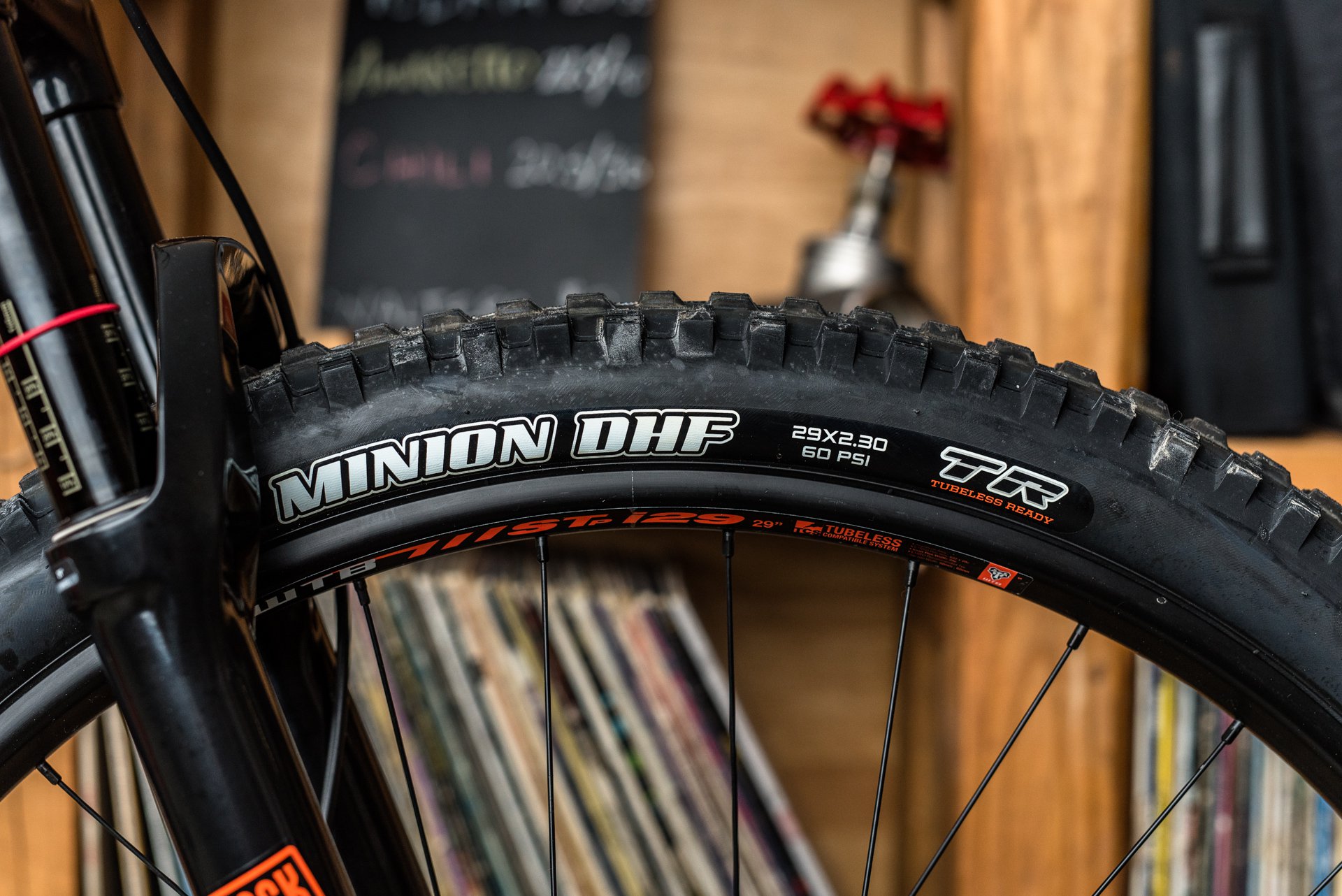
Tubeless ready Maxxis rubber mounted on a tubeless compatible WTB STP i29 rims.

The Tomahawk is one of those blah all-in-one products that doesn't make anyone happy.
The surprise hit of the package is the 140mm RockShox Revelation RC fork which is essentially a cheaper Pike. As a believer in 29+, I love the fact it can swallow a 29 x 2.8" tire with room to spare. My 29 x 3" Bontrager SE4 measures out to 29 x 2.843" on a 40mm rim so rounded down I'll definitely need to try that at some point!
I set up the air spring to the recommended pressure for one weight class heavier than I sit, left the compression adjustment on the Motion Control damper in the open setting, and set up the rebound adjustment as fast as I can comfortably ride the fork. Very happy.
If it's my wallet and I'm choosing between a Pike and a Revelation I'll happily take the Revelation and change.
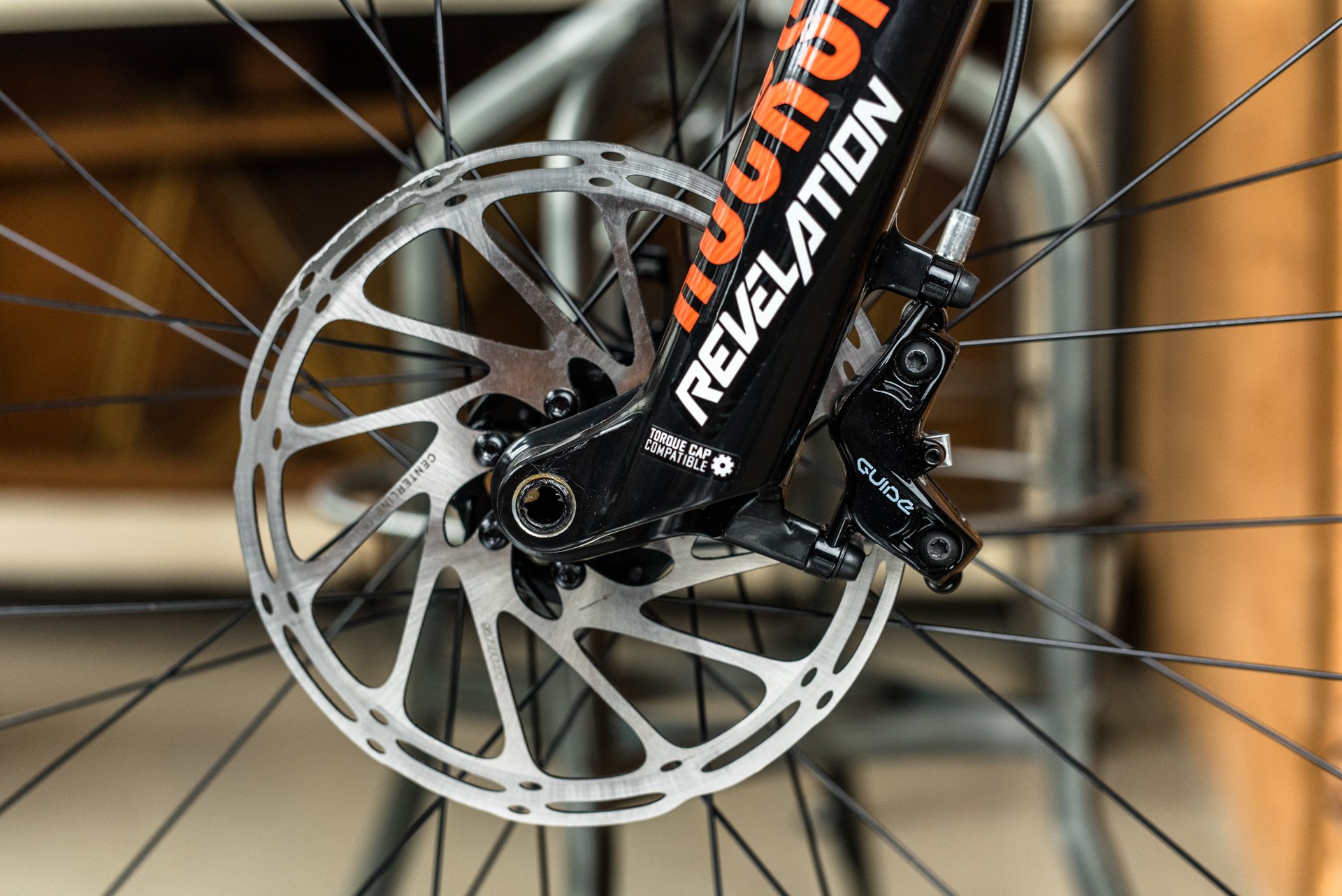
The new Revelation RC fork is a... well... revelation.

The mug is... well... surprising.
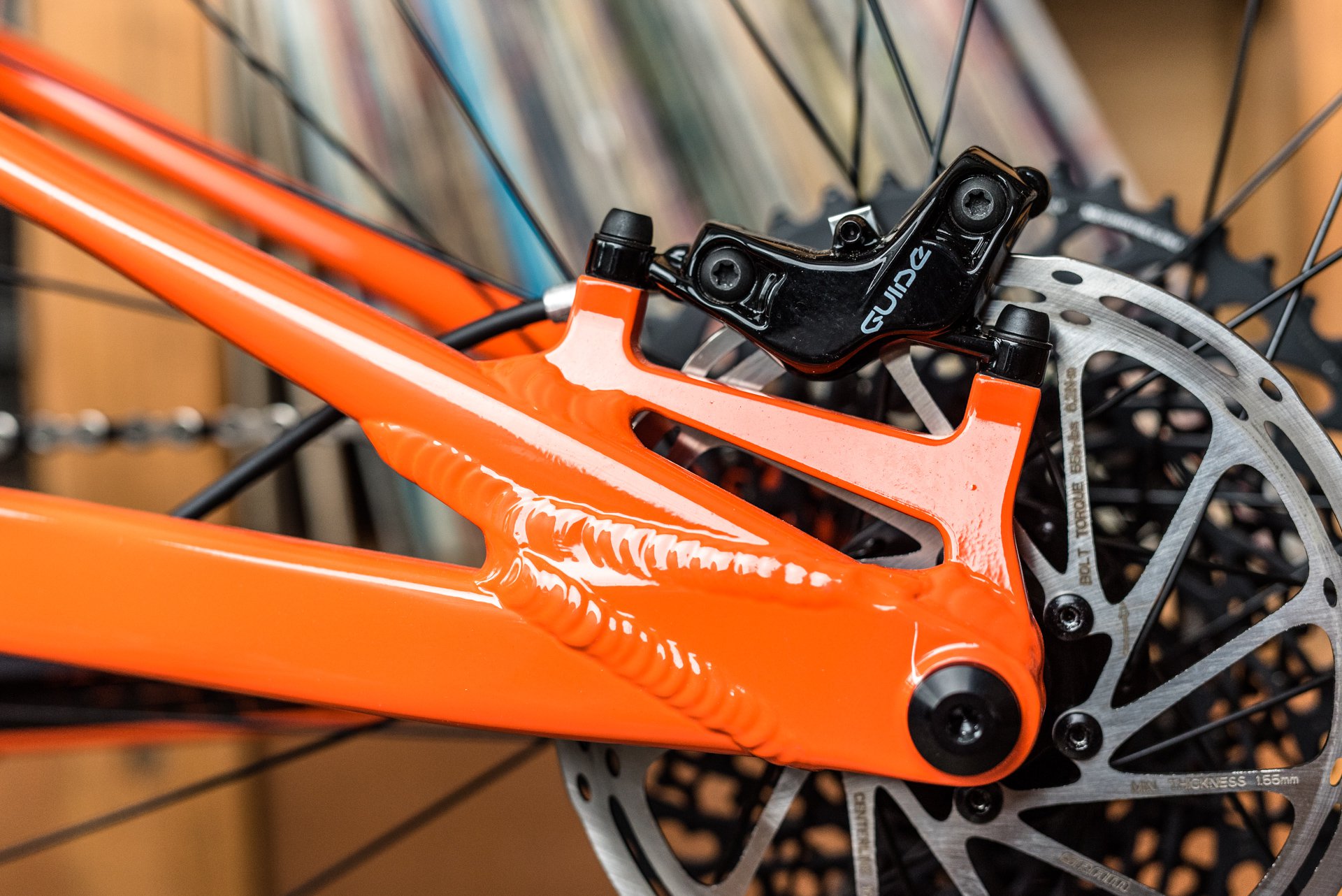
The lack of a seat stay pivot, on the other hand, is not. See the Hei Hei lineup.
I know that lots of riders, including Cam, are gravitating back to narrower bars and on a large frame that's really more of a medium-large, a 760mm bar is probably acceptable to the majority of riders. I'd still like to see an 800mm bar stock and the Kona dealer cutting it down for a given customer's preference.
I swapped the bar out for my personal preference, which is 780mm, with a bar I had in my shop but for a rider who doesn't have a 35mm bar, or appropriate 31.8 bar and stem kicking around, that would be an extra expense at the time of purchase.
Frame Notes
The Satori shares the silhouette and signature frame details of Kona's racier Hei Hei 29'er. A short top linkage actuates a vertically mounted shock and there is a notable lack of a seat stay pivot.
Kona is relying on a small amount of flex in the rear triangle as the suspension cycles while theoretically saving weight, gaining lateral stiffness, and reducing maintenance. Based on other manufacturers I've talked to (for example, Marin's bikes with a similar layout, like the Hawk Hill I tested, have such a tiny amount of movement at this seat stay pivot junction that they've found bushings to be significantly more durable than bearings for the application) I'm totally on board with Kona's design here.
The Hei Hei platform has proven to be very durable and for anyone concerned, Kona is a company that still offers a lifetime warranty on their aluminum frames.
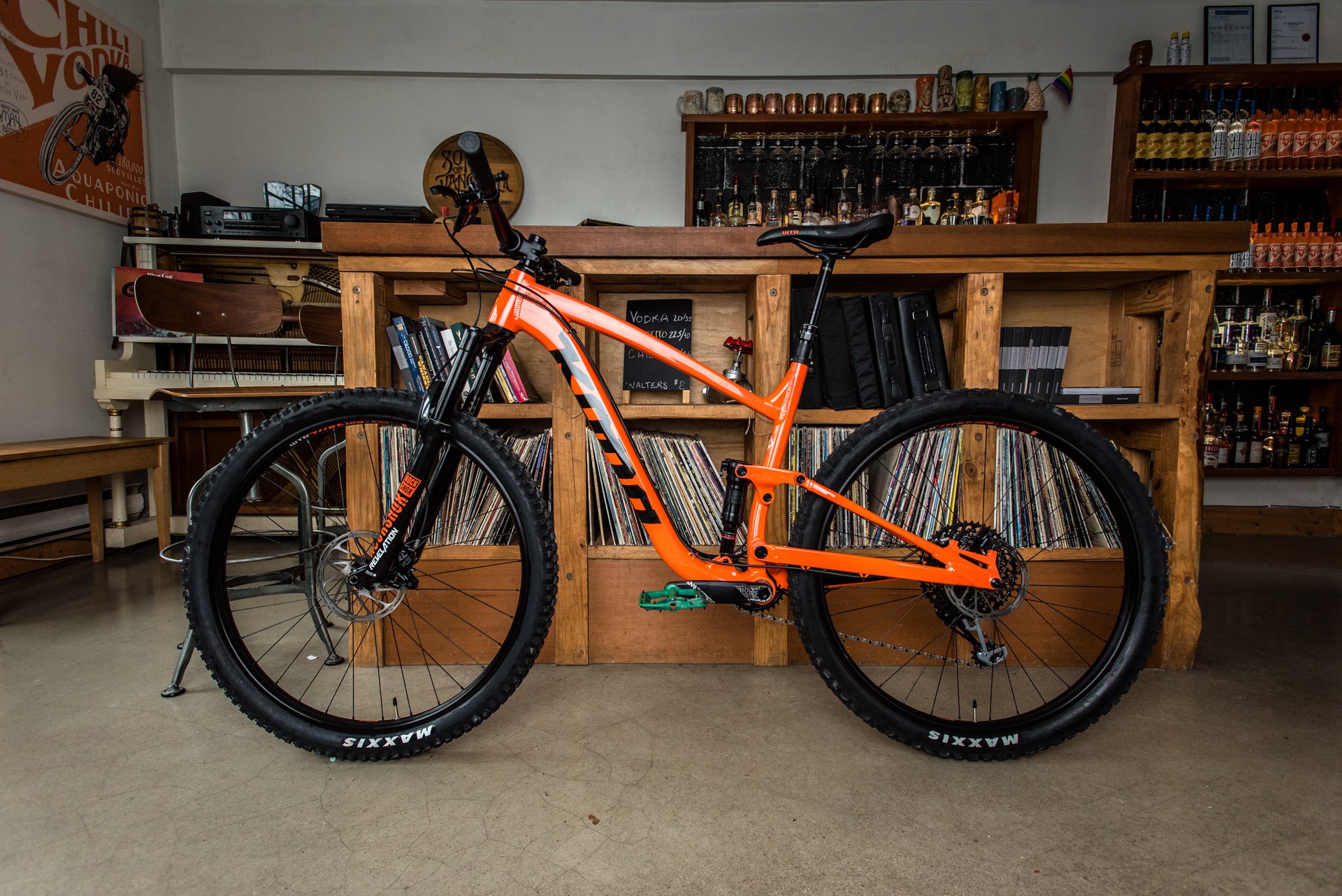
The Satori looks a lot like a longer travel Hei Hei 29'er but early rides suggest it's a slightly more efficient Process 111.
I prefer external cable routing so I'm biased in this case, but I think Kona has done a slick job getting housing from the back of this bike to the cockpit. I like the top-of-the-down-tube routing for the rear brake, dropper post, and derailleur which should satisfy critics of below the down tube housing exposure while keeping movement as the suspension cycles to a minimum.
I understand that with carbon bikes it's easier, and cheaper, to drill holes in frames than to reliably attach cable guides but I'll take the Satori routing on any bike, any day, over anything else on the market.
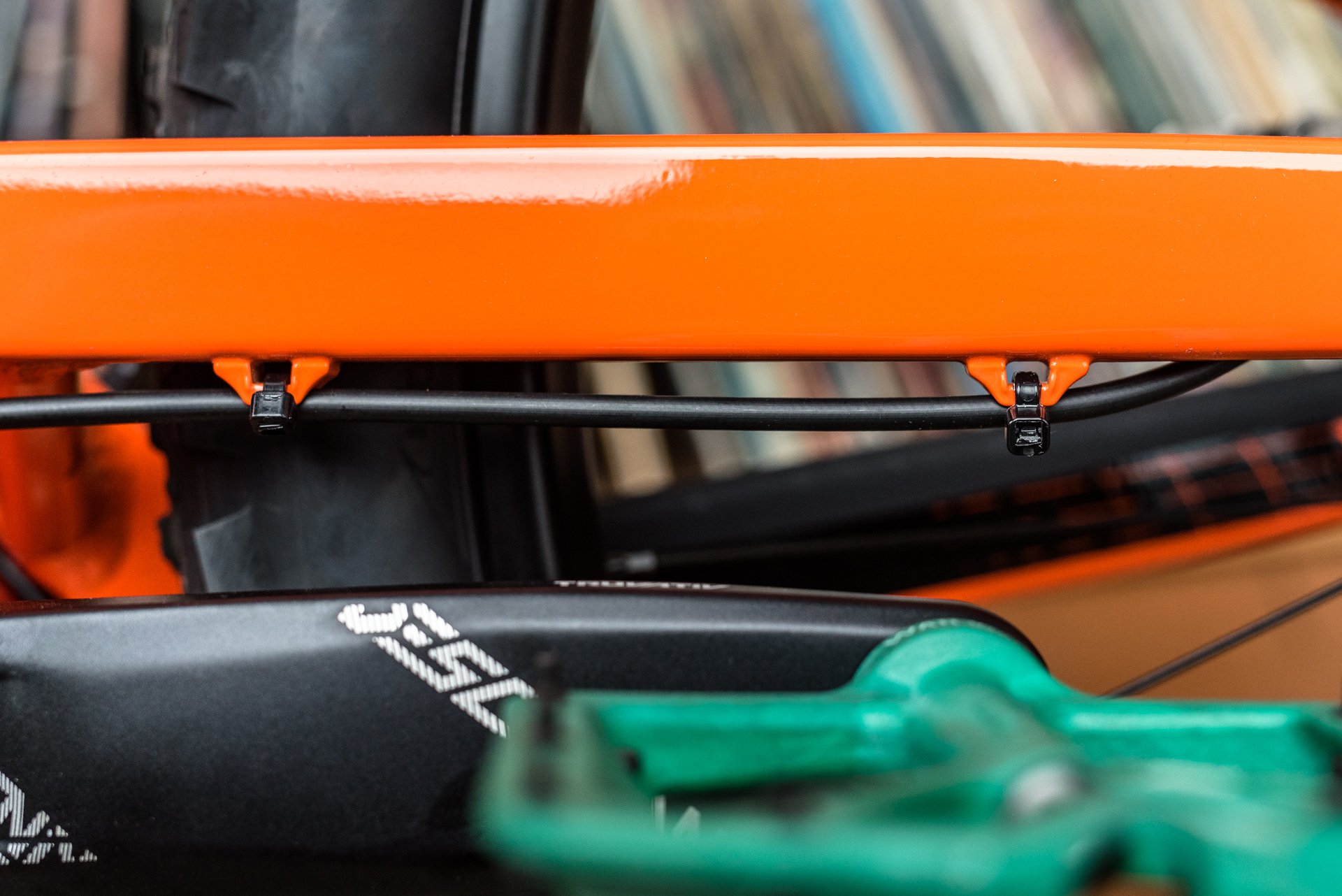
All cable routing is external except for the Stealth dropper which exists from the seat tube.
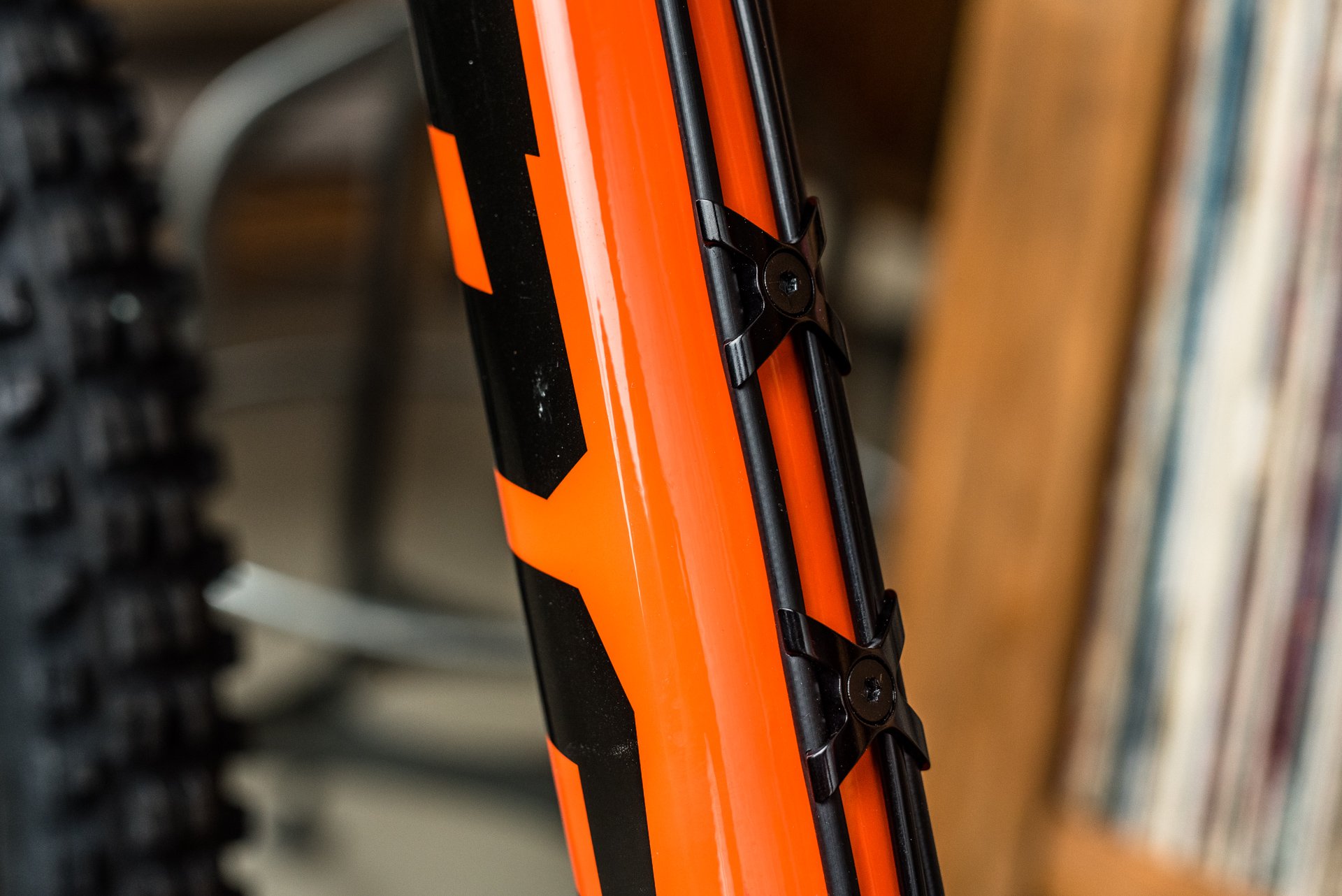
I like the utilitarian bottle bosses that double as cable guide mounts. I say clean, others say clutered.
It's a given that new bikes are moving to Metric sized shocks and the obvious advantage is more fluid in the damper for a given stroke for most manufacturers. The challenge in picking a new bike comes down to a choice between a trunnion mounted shock, like on the new Satori, which has additional oil and bearings in the linkage instead of a standard eyelet and DU bushing.
Personally, I'm a fan of DU bushings. They make it very obvious when a new one, or fresh mounting hardware, is required. That said, Trek, Giant, and others have been leading the Trunnion mount charge and I have heard very, very few examples of seized bearings causing any issues with shock wear or frames cracking.
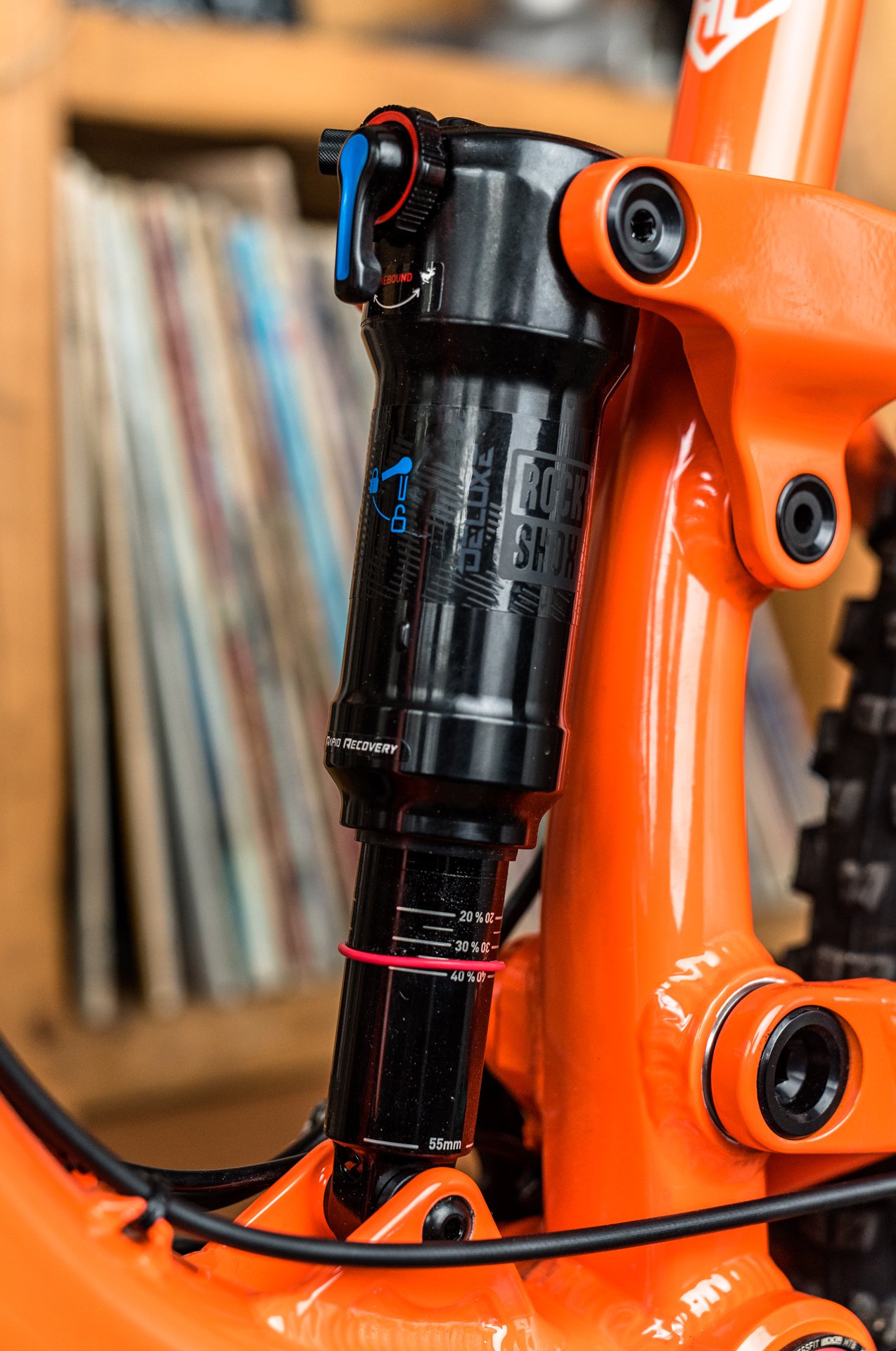
More clean cable routing.
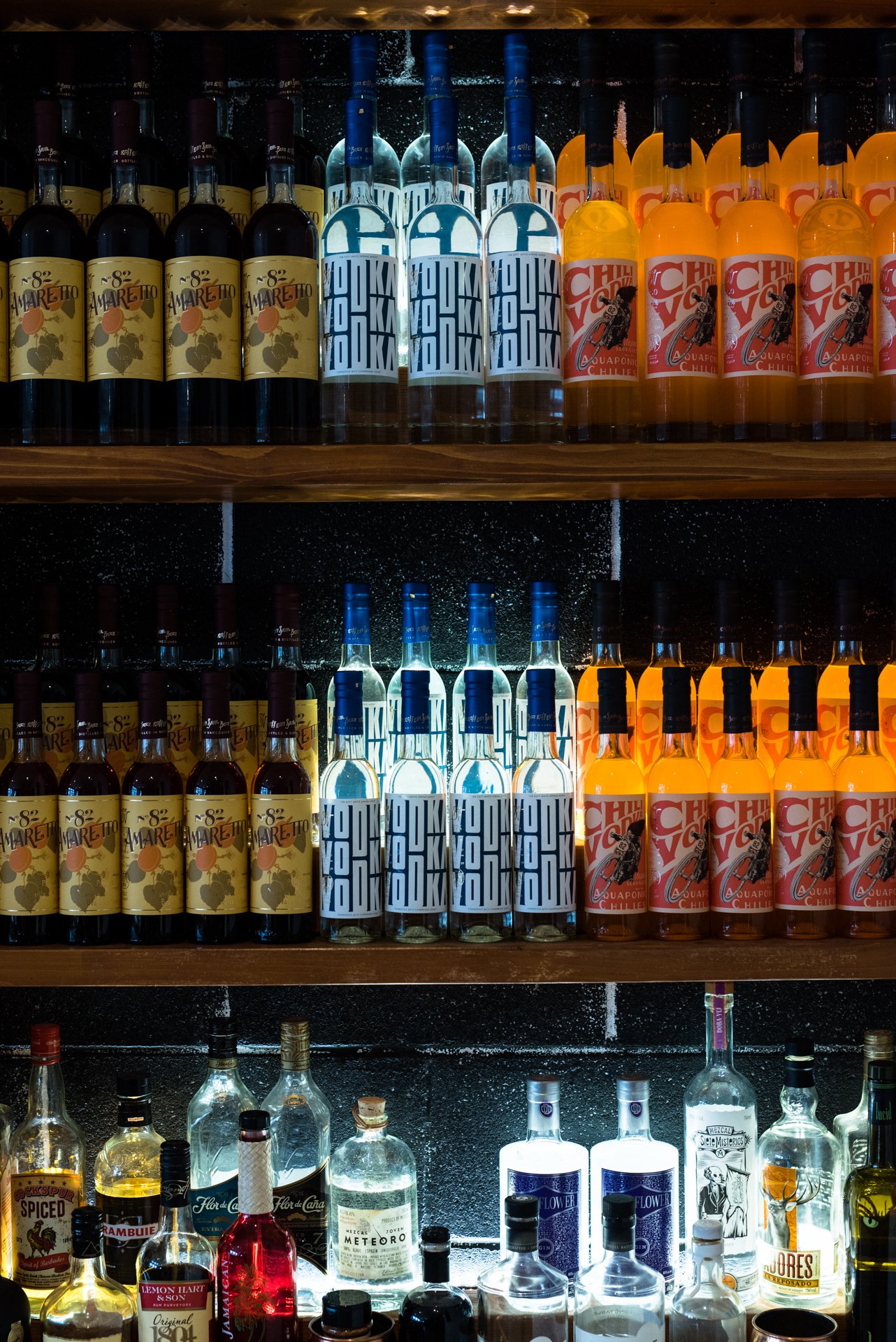
Speaking of keeping things organized.
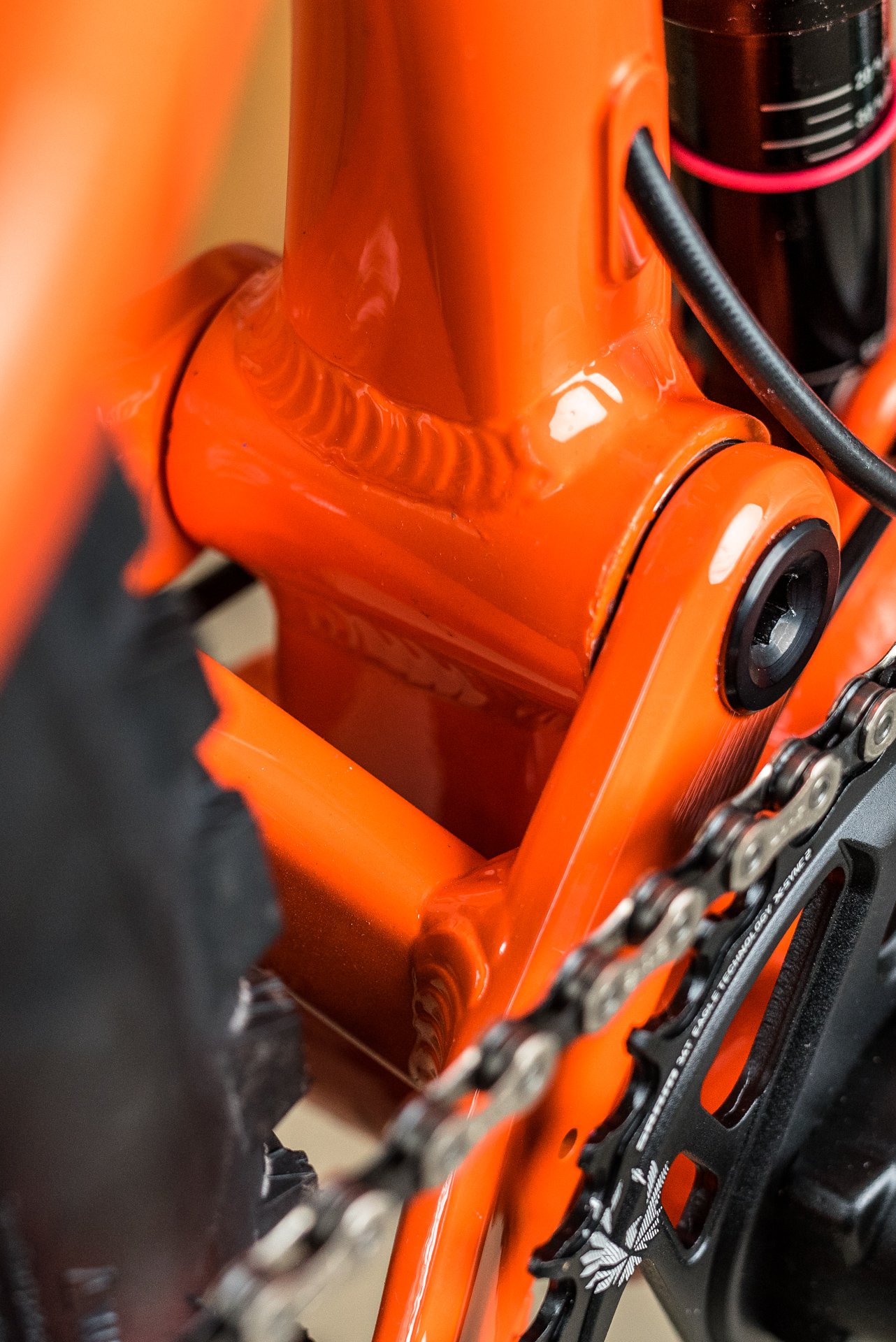
The only internal routing on the bike.
Bike Review
It's always a mixed blessing when I jump on a bike and I'm immediately comfortable. There's no material to be mined from intricate setup rituals or sourcing exotic upgrades. Setting up the suspension was a matter of starting up one weight class from the recommended air pressure in the Revelation and approximately riding weight in the Deluxe shock and then some minor tweaking from there.
I'm looking forward to putting a ton of hours on the bike because it fits awesome. Potential tweaks include trying a slightly longer travel fork and possibly throwing my CCDB Coil shock on if I can find or make hardware, something I've seen done on a couple of trunnion mount Treks. I have some different tires I'm going to ride on the bike as well.
All in, my first impression is that anyone looking for a 130mm/140mm trail bike 29'er in the 3,500 USD | 4,500 CAD price range should definitely have the Satori DL on their short list. There will also be a more basic Deore spec Satori model with a Recon Gold fork up front that will list at 2,700 USD | 3,500 CAD.
For more information, both Satori models are now live on Konaworld.com







Comments
dtimms
6 years, 1 month ago
Interesting your thoughts on the Revelation. Does it really perform as well as the Pike?
Reply
Andrew Major
6 years, 1 month ago
That depends entirely on your take on the Charger damper.
Personally, I prefer RockShox forks setup with ‘less damp and more ramp’ so I leave the compression adjuster in it’s lightest setting, run the rebound as fast as manageable, find an initial air spring feel I like (in most bikes that’s towards the higher pressure recommendation for one weight class up) and then fine tune with tokens (and sometimes 1/2 tokens).
They are the only forks I run this way, but I’ve had good results at every pricepoint from the Recon to the top end Lyrik.
With all that in mind, I personally don’t see any reason I’d buy a Pike over a Revelation at SRP.
Reply
dtimms
6 years, 1 month ago
Thanks for the details. I have enjoyed my Pike but I also don't get super particular. I just set and forget. Fork has got super harsh since losing 30 lbs. So need to reset the SAG and tune this spring when I start riding again. But good to know on the Revelation. It is an option on some bikes I am looking at so maybe I won't be as scared of the fork as the old Revelation.
Reply
Andrew Major
6 years, 1 month ago
If your Pike doesn’t have the new SKF seals I’d highly recommend the upgrade (and you’re likely due for a service).
Reply
IslandLife
6 years, 1 month ago
That an interesting take on Rockshox's... I've got a new Yari and was just starting to consider the charger damper, but I may try some similar settings to yours before I do.
The Charger swap isn't cheap and I'd just hate to go through with it and not be suitably impressed.
Reply
Andrew Major
6 years, 1 month ago
So I've replied to this a few different ways in my mind. I don't want to be accused of self-censorship but I think as a bike-nerd & reviewer I can sometimes be justifiably accused of focusing in on product weaknesses without adequately highlighting strengths.
For example, I'm a SRAM fan - especially of the actions they've taken to support local shops through competitive global price structures and grey market controls - and I quite like Eagle but I've been looking over my shoulder for the nihilist hit-squad from the Big Lebowski ever since I pissed off zee SRAM-Tchermans by noting the relative length of an Eagle derailleur cage to a 27" wheel and - jokingly - saying their new narrow wide rings look like the result of drunken whittling.
So, a couple of different replies but keep in mind I think your Yari is an awesome fork (and would personally buy one over a Lyrik based on price but am not saying the Lyrik isn't awesome):
1) I've had great riding experiences on the Lyrik, Pike, and so far the Revelation so I'm certainly not shitting on the forks. RockShox has obviously influenced every companies' air systems in a very positive way.
But, I've never found Charger to be an upgrade. I've heard that PUSH has a custom tuning program that makes a big difference but I read a piece somewhere on how Nicolas Vouilloz sets up his RockShox forks, tried something similar with my setup, and never looked back.
With the fork setup as I've noted it, I don't perceive any advantage of the RC3 over an RC Motion Control damper. Obviously, this is one opinion and I welcome anyone who has had a different experience to share it.
2) Just as coil shocks and forks are making a comeback, I think saving weight by running bladder dampers in forks (Charger, FIT, etc) other than for light trail and XC racing applications will disappear as legacy products leave the pipeline. All the credit to Ohlins for leading the charge in putting oil back in forks.
So, if I was looking to upgrade the damper in my RockShox fork I would absolutely follow that trend and get an Avalanche Racing damper. I ran one in my Fox 34 years ago and that's still my favorite 29'er fork I've owned (with an old Fox air system to boot).
I'd love to try the latest generation RockShox air systems with an Avy damper. I think it would blow my mind.
I have no inside information about RockShox specifically but I'd be surprised if we don't see an entirely new take on damping from them in the next couple years just knowing where other companies are going.
Reply
IslandLife
6 years, 1 month ago
Thank you for taking the time for such a comprehensive reply, it’s very much appreciated. The more I research my Yari, the more I realize it’s inherent value. And the more I realize I need to be more aggressive with testing some different setup changes. Not to say I haven’t been happy or impressed with the fork so far... I’m just the kind of person who isn’t satisfied until I’ve squeezed every nugget of possible performance gains from my components. To a point of course, which is why I asked about the charger/charger 2. Just spent a bit of time on the Avalanche page... wow, but that price as well. Anyway lots to think about and play with. Thanks again!
Reply
Andrew Major
6 years, 1 month ago
Anytime. I enjoy deep dives into min-maxing bike stuff.
Strictly speaking SRP prices, a Yari (call it a chassis and air system) and Avalanche cartridge aren’t much more than a top end fork.
If you already own the chassis as a sunk cost and look at what you can get for it used + $ for a new Gucci fork then I think the Avy is a relative value.
Don’t get me wrong, cost no object I’m Ohlins Coil every time, but there are a lot of creative ways to make stock forks kick ass.
Agleck7
5 years, 10 months ago
Switched my Pike set up based on your recommendation here. Love it. Is this the Nico article you mention? https://www.bikeradar.com/us/mtb/gear/article/pro-bike-nico-vouillozs-lapierre-spicy-team-45599/
Reply
Andrew Major
5 years, 10 months ago
The pictures are not familiar but that doesn’t mean that’s not where I first saw it - I do feel like it was an older article though.
Glad the set up’s working for you!
Agleck7
5 years, 10 months ago
Interesting discussion on this setup point during Brendog's Leogang race run with Warner and Claudio. Apparently BOS philosophy is low spring rate w lots of damping and Brendog prefers very little compression w high spring rate.
Reply
danielshiels
6 years, 1 month ago
I bought a tomahawk 3c maxterra dd for £25 on offer last year and it made a decent summer rear tyre. Only issue was that it burned away faster than any tyre I have ever used. Can imagine in a harder compound the grip would suffer so have to agree I'd never buy another. My 10 cents
Reply
Jeff H
6 years, 1 month ago
I do know Sons of Vancouver make a Bangin Caesar.
Reply
Andrew Major
6 years, 1 month ago
Mmmm...
Reply
phile
6 years, 1 month ago
two words that have not been used together since the end of the Roman empire.
Reply
Perry Schebel
6 years, 1 month ago
the aluminum flex stay is interesting. seems intuitively worrisome, but smarter minds than I developed this, so i assume will be fine. i do like the idea of utilizing flex elements to eliminate pivots.
Reply
Andrew Major
6 years, 1 month ago
My guess is the dropout area is manufactured such as it is to spread those limited flex loads through the whole rear end.
I’ll be able to talk more about that as part of the long term review (thanks Cooper). My personal FS bike uses essentially the same layout but with a seatstay pivot so I’ll hopefully be able to quantify how insignificant the movement is at the pivot (allowing an educated guess of what’s being spread through the frame here).
Nerd talk aside, it hasn’t been an issue at all with the Hei Hei Bikes (I thought the flex might crack paint over time) and the the frame has a lifetime warranty.
Reply
Perry Schebel
6 years, 1 month ago
yeah, the dropout area certainly has some additional beef built in (compared to the heihei). i'm kinda fascinated by the process of engineered compliance in a material with (relatively) limited fatigue resistance. curious what kind of deflection is encountered during full travel. anyone keen to air out the shock and pull out a straightedge? fwiw, i've got a 10 yr old carbon dh bike that relies on chainstay flex in lieu of a dropout pivot - that's soldiering on just fine to this day.
Reply
Andrew Major
6 years, 1 month ago
Re. cycling the rear without air, I’ll be getting on that as part of the review.
I get that aluminum is not as compliant or resilient as many steels but we’re talking about such minimal flex here - it isn’t a Fango - I started wondering why more companies (especially small builders working with steel) aren’t doing it. Definitely will explore that more as well by talking to some companies that haven’t gone this route.
Reply
Geof Harries
6 years, 1 month ago
I own a 2016 Kona Hei Hei and am a fairly big guy (6'3", 195 lbs). I took the Hei Hei into my local bike shop this week to get some maintenance done and asked if they could figure out where the creak was coming from. That creaking started in late summer and got worse in the fall, but then the snow came, so...
Anyway, it turns out I have cracked the chainstay on the drive-side, ahead of the rear derailleur. This is the second cracked Hei Hei rear-end that this shop has seen. I'm really hoping that Kona can replace the rear triangle under warranty.
So, the flex definitely is a concern. Although, my Hei Hei was the first generation of the new models. Perhaps they've beefed them up since then, including the chainstays of the Satori.
Reply
Andrew Major
6 years, 1 month ago
It’s been quite a few years since I worked in a Kona dealer but in my experience the aftersales support is excellent. Obviously I don’t know the whole situation but I’d guess you get well supported - let us know how it unfolds.
It’s easy for me to say, but there are examples of everything breaking whether it’s the alloy frame of a 3k bike or the carbon frame on a 13k bike - I appreciate the examples though (first I have heard of).
Hope you are back riding soon!
Reply
phile
6 years, 1 month ago
Nice write-up. I'm a fan of small chainrings--seems like they're not specced because they're not cool. Since you're the one who did the NSMB Mattoc review, where would a Mattoc w/IRT fall within your continuum of RS forks?
Reply
Andrew Major
6 years, 1 month ago
Hi Phile,
Thanks! Apologies for the delayed response. Had to think on this one.
So I wouldn’t directly compare the IRT Pro Mattoc to an RS product. I mean, depending on the model it competes against the top end Pike or Lyrik but the IRT forks are a different setup experience which I’d compare to an Ohlins air fork. Keeping in mind they’re all providing good traction in rough terrain the IRT is much more sophisticated in terms of adjusting it to ride very different ways where the RS forks, for me, all work as I’ve described +/- tokens.
The Manitou IVA Mattoc is a better direct comparison as it does uses volume tokens to the same effect but I do run a bit of preload on the LSC and HSC adjuster.
Where RockShox wins is the rampant availability of parts, tire clearance for a given travel, and regular appearance.
Where the Manitou wins is the better damper, unique appearance, and adjustable hydraulic bottom out.
If it comes down to a 140mm Lyrik RC3 vs. a 140mm Mattoc Pro I give the nod to the Mattoc Pro solely on the hydraulic bottom out system which every aggressive mountain bike fork should have. I use full travel regularly and never feel brutal hard bottoms.
Hope that makes sense!
Reply
phile
6 years, 1 month ago
Thanks a lot for the thoughtful reply. I own a Mattoc Pro--and as of the mail delivery today, I own an uninstalled IRT. Seems like a perfectly rad fork to me, but I have little to compare it to besides a handful of recent demos, so I was curious to hear a more expert opinion. I'm looking forward to fiddling with the IRT, and enjoyed your write-up of it. Cheers!
Reply
Andrew Major
6 years, 1 month ago
Cheers! Enjoy. I like the fork with IVA but a tinkerer will get more out of IRT for sure.
Reply
UFO
6 years, 1 month ago
As an owner of the original Satori, I found it to be very capable. I size well to most makes' mediums, and sized up to a 19" M/L in the Satori for the reach and really enjoyed it. I think if it had the standover of a 17.5" bike I'd still own it also, but thus is the progression of geometry over the past 5 years.
I had read from a poster on the other site that figures there is about 10-12mm of flex in the stays. Not a ton to be concerned about but enough for me to be wary about picking up one of these pre-owned without Kona's fantastic lifetime frame warranty.
Reply
Riley
6 years, 1 month ago
Wait, you say the bike does not have a water bottle mount inside the main triangle but has bottle bosses that double as cable guide mounts? Can you mount a bottle cage on top of the cable guides?
Reply
Andrew Major
6 years, 1 month ago
There are definitely bottle bosses - they double as cable guide mounts.
You just mount a bottle cage on top.
Reply
Nouseforaname
6 years, 1 month ago
This seems like a less well specced, more expensive, steeper Fuel EX 8. With janky cable guide/bottle cage mounting.
Reply
Andrew Major
6 years, 1 month ago
I covered the love it/hate it of the cable routing in a caption. I’ll definitely take it over any internal system but everyone (who isn’t a bike mechanic who looks at internal routing as a money maker _cough Jeff cough) _is entitled to their opinion on external vs. internal routing.
It has a very different ride from a Fuel EX 8, or any of the Full Floater ABP bikes, but aside from that it’s a great comparable.
Aside from any Fox vs. RockShox preference the spec is virtually identical? Price wise once a rider replaces the Bontrager dropper post with pretty much anything else it’s a lot closer. Also, Trek is the biggest bike company in the world so I’d expect them to deliver a slightly better spec value through the same retail channel.
Good food for thought though - thanks. I’d definitely recommend that anyone who can ride both bikes before dropping the cash.
Reply
Nouseforaname
6 years, 1 month ago
I rode a Fuel Ex for a few laps and was super impressed with it, i think with the higher main pivot this 'might' be a better shore bike. Interesting to do a shootout of two good "Eagle drivetrain but alloy frame bikes".
Reply
Andrew Major
6 years, 1 month ago
Agreed. The Fuel EX is also such a nice aluminum frame it would be a great bike for a carbon vs. aluminum faceoff (EX 8 vs. EX 9.8) if one wanted to put aluminum's best face forward.
Reply
snorris
6 years, 1 month ago
> once a rider replaces the Bontrager dropper post with pretty much anything else
Sounds ominous. My Bontrager Drop Line post is fine but I haven't used it much yet - are there known issues?
Reply
Andrew Major
6 years, 1 month ago
I’m a big fan of a lot of Bontrager products. XR4 29x2.6 tires, SE4 29x3” tires, the Rally MIPS helmet, Line Comp wheels... awesome stuff. When it comes to dropper posts Trek/Bontrager should have followed the policy that led them to dumping the crank line or, worst case, rebadged an X-Fusion Manic.
If your post doesn’t sound like a 40-year veteran chain smoker chewing Tic-Tacs while singing Hotel California then maybe you’re good to go. Neither my experiences or anybody I knows experiences have been recommendable.
Reply
snorris
6 years, 1 month ago
Interesting, thanks for the reply.
Those tires sound interesting too, I didn't know 3.0 SE4s were available. I'll probably try them on my Stache - thanks for your earlier reviews on that.
Reply
Andrew Major
6 years, 1 month ago
The XR4 and SE4 are both available in a 29x3". If weight > durability/support I've actually had a great experience with the 29 x 2.6" XR4, so I think the 3" version would offer better support than say a Chupacabra.
That said, if you don't mind a few extra grams the support from the SE4 is very good. I prefer the SE4 over the 3" Minion 3c I was running for use on both my rigid bike and my full suspension rig with the exception of some really steep/greasy chutes where I think Maxxis rubber still wins on the hairy edge.
Enjoy!
Carbonzo
6 years, 1 month ago
Thank for the impressions. The photos are amazing!
I share the opinion about the Eagle 12spd, I see absolutely no reason to use 50t cog with anything smaller then 36t up front.
My HeiHei race DL can only accommodate 34t, and so - I'm happy with a 9-44 cassette. (Which annoyingly was discontinued).
That begs the question - can the Satory accommodate anything larger then 34t?
Reply
Andrew Major
6 years, 1 month ago
Dave totally nailed the photos for this piece!
We’re actually saying the opposite thing re. chainrings. My personal (over 30lb) 29’er I run 30tx9-46t and I’m advocating Kona spec 30tx10-50t on the Satori - I think it would make more riders happy.
That said, I’ll definitely find out if a 36t fits.
Reply
Carbonzo
6 years, 1 month ago
Thanks for the reply -
Do you feel much difference between the 46t and the 50t? (aside the 12 speeds of-course)
I think that the Satori is more of XC-Trail machine (given the somewhat disappointing head-angle and the insane 78deg STA... so a 34t may make sense. especially if it pedals well. but I get your point. looking forward to hear about the 36t though!
Reply
Andrew Major
6 years, 1 month ago
I’ll ask Dave to do the action shots on something really janky. It’s not a Process 153 29’er but the Satori has stones. I did anticipate the comment though. I say check out the Process 111 vs. Satori geo charts I included and then read some 111 reviews. Numbers only get you so far.
Based on other bikes: Yes, there is a big difference between the 46t and 50t when I’m in the situations where I NEED the baby gears.
34tx50t is rideable pretty much everywhere but I end up making use of way less of the cassette than with a 30t where I spend a lot more time in good chain line situations.
Reply
Merwinn
6 years, 1 month ago
Carbo, around these parts a 34t almost guarantees future knee replacement surgery as NS terrain is typically technical and/or steepish ups and downs with quite ltd flat sections other than forestry road between trails. You local to the PNW?
Reply
Carbonzo
6 years, 1 month ago
Hi,
Well, no, sorry - I'm from Israel. So it's only local as 14hours flight can be called local ;)
However, I live in a mountainous area - there's rarely any ride with anything less then 1000-1200ft vertical ascend, usually more. (e.g. - Today was 2,700ft). also - very rare flats here. ups, downs, rocks... However - I don't like the feeling of "pedaling on empty" - if that makes any sense. like - there's no feedback from the bike, even though - it's obviously physically demanding :0
Reply
Vincent Edwards
6 years, 1 month ago
I'm interested to hear more in-depth feedback on riding a bike with a 78+ degree seat angle.
If my figures are correct, that would put the seat over 1 1/2 inches further forward relative to the cranks compared to the 73 degree angle on my Tallboy 3. At the moment, I have my seat all the way forwards, and really appreciate what that does for my position on the bike. If I had to guess, I think I'm running about a 74.5 effective angle in that position. You would need to slam the seat all the way back on the Satori to get into the same position.
I hope I can demo a Satori this spring- I'm intrigued. Between this bike and the new Smuggler, we are seeing two unique and progressive approaches to new school geometry.
Reply
Carbonzo
6 years, 1 month ago
Also interested.
Even more interested in the philosophy behind the STA:
As far as I know - you setup the saddle when reaching a certain "sweet-spot" position of your knees and ankles relative to the pedals. Hence - if the STA is around 73ish - the saddle will be placed forward. 76ish - slam it to the back to maintain same position relative to the pedals. So why is that number important?
Further more, isn't it possible they "over-done" it and now you miss that "sweet-spot" by being too close to the front of the bike, sacrificing the ability to get to the right position?
Reply
Vincent Edwards
6 years, 1 month ago
From what I understand, that perceived 'sweet-spot' is creeping forwards, and with that we are seeing steeper effective ST angles and longer reach numbers without changing ETT much. I think the goal is to end up with a bike the both climbs and descends better, while being more stable as a product of longer wheelbase and front center.
But yeah- I wonder how far is too far? I'm glad brands like Kona are willing to experiment. Personally I would imagine running this bike with a 150 fork and pushing the saddle back a bit to get my desired fit on a Large.
I was expecting a bike like this from Kona, but guessed it would have a 67 degree HA and 75-76 degree SA more in line with the new process models.
Reply
Carbonzo
6 years, 1 month ago
My thoughts exactly. It almost "begs" for a 150-160mm fork upgrade. That will have you with more-capable 67-67.5 HTA, and still-exotic-77.2-77.7STA. Maybe Kona wanted a great upgrade platform?
But hey, maybe we're missing something - these guys seem to know what their doing...
Reply
Andrew Major
6 years, 1 month ago
Everyone I know well with a Honzo ST (over ten people) and Process 111 run +20mm travel on those bikes. If I owned a Satori I’d definitely consider a 150mm or 160mm fork.
That said, it’s easy to get caught up in numbers. I was riding Lower Crippler On Fromme before the recent snow fell and the 140mm/68 setup on this feels great with the combination of 29” wheels and the bar height I’m running.
Reply
Andrew Major
6 years, 1 month ago
I think the 78-degree STA is a smart decision on Kona’s part. It’s frankly where bikes are going and like the Process line they are getting out front of a trend for bikes they’ll be selling for a few seasons.
The steeper STAs accommodate longer standing Reach numbers while maintaining similar ETT numbers for seated riding (as has been noted) and they also make for more seat tube vs. tire clearance for longer travel bikes with super short stays.
It will be interesting to nuance as this is by the far the steepest STA bike I’ve ridden and steeper than I would choose if building a bike myself (I also prefer longer CS) but I feel I get what Kona is up too and thus far - a couple rides in - I’m impressed up, down, and across with the total package (a good reminder to not get too stuck on geo charts).
If I can make a long term prediction I think STA will end up being size specific for all brands. Say 78 for XXL, 77 for XL, 76 for L, 75 for M, and 74 for S. It’s all relative to saddle vs bb position.
Reply
Vincent Edwards
6 years, 1 month ago
Thanks for the update!
I would love to see STA and CS become size specific. This seems like a place where forward thinking manufacturers who build aluminum bikes could compete against the 'carbon only' companies who are using one rear triangle on all sizes to save cost. At 5ft 10 I am usually happy with the 'middle of the road' numbers, but I'm all for shorter and taller riders having bikes that fit and ride equally well.
Reply
Carbonzo
6 years, 1 month ago
But the question remains;
If a "bike-fitter" position your saddle relative to the BB (horizontally and vertically) - what is the influence of the STA? in other words, if your location relative to the BB is set to maximize wattage output, and set according to hip, knee and ankle angles, why is the STA matters?
In any case a bike-fitter would rise and slide the saddle to it's best position - regardless of the STA, and so - I'm unable to determine its importance.
in other words: if you have 10 bikes that differ ONLY in the STA, and all of them were fitted to have the saddle at the exact same height and horizontal distance from the BB - would you feel any difference between the bikes?
Reply
Andrew Major
6 years, 1 month ago
So first of all you can’t ignore the frame mechanics of a steep STA. It isn’t all about fit relative to the BB.
A steep STA provides more clearance between the tire and seattube allowing for more travel and/or shorter stays vs. a slacker STA and pushing the seat forward.
Fit wise, slackening the STA grows the effective top tube length but not reach. For an extreme example look at a bike like a 2007 Knolly Endorphin which had a relatively long top tube with the seat extended and yet a relatively short Reach.
The steep STA let’s a company optimize Reach (and Stem length) without the ETT growing so long as to make the bike unrideable seated.
Saddle rail adjustment range is actually quite limited physically and moving the saddle forward shortens to ETT from the position of where the rider is sitting which often requires a longer stem (generally not desirable) so usable fitting range from saddle adjustment is never going to let Bikes with very different geometries be adjusted to the same seated pedaling position.
Lastly, these are suspension mountain bikes. No matter the amount of anti-squat or Propedal (short of eliminating traction with a true lockout) they are going to have a rearward sag bias climbing that increases along with the grade. It’s only a 78-degree STA on flat ground.
bmak
6 years, 1 month ago
Are there any details on the weight?
Reply
Andrew Major
6 years, 1 month ago
I apologize, it wasn't an oversight but I don't personally care so I've never invested in a scale and the opportunity to weight it didn't come up before I wrote this piece.
I've already swapped a tire and installed a wider bar on it but I'll try to weight it with the stock build when I return it.
Thanks for asking!
Reply
bmak
6 years, 1 month ago
Thanks! Just curious as to where it stacks up against other similar 29ers. I know the Smuggler is a bit on the heavier side, whereas the Instinct seems to be a pretty light alu bike.
Reply
Vincent Edwards
6 years, 1 month ago
One online bike review site has it listed at 30.5lbs - I think they had a large DL
Reply
Gael
6 years, 1 month ago
I would like to try this bike.
I'm tall 6.2", and my saddle height is 2,8". So STA for me is important. It must be almost 75°. I ride quite only apine trails, so they're generally really step. I've tried the Fuel EX 9.9 21,5" and my feeling was that the bike was too short. Also the head angle was too closed. It's seems that the head angle is really closed also on this bike, but perhaps as the reach is longer it'll have less understeering?
Reply
Gael
6 years, 1 month ago
And what about a down tube protection? Now on the market we can find a lot of trail bikes with it.
Reply
GuyC
5 years, 10 months ago
I'm sooo pleased that someone has done this review! I really wanted to go and see the new Satori yesterday at a local demo day, the first I've seen Kona at in Cornwall UK, unfortunately I couldn't go and was gutted.
I own a 2012 satori with 130mm rev dual air forks and id consider myself a beginner / intermediate rider but I have to say it's easily the best bike I've owned.
It's a very flattering bike to ride and I've absolutely smashed some local downhill enduro tracks on it, it gives you confidence and makes everyone think you are a better rider than you actually are! I think the head angle is just right, any more and it would be more enduro, this I can dabble in with the bike and not feel out of place whether at a bike park or a local trail.
Reply
Please log in to leave a comment.